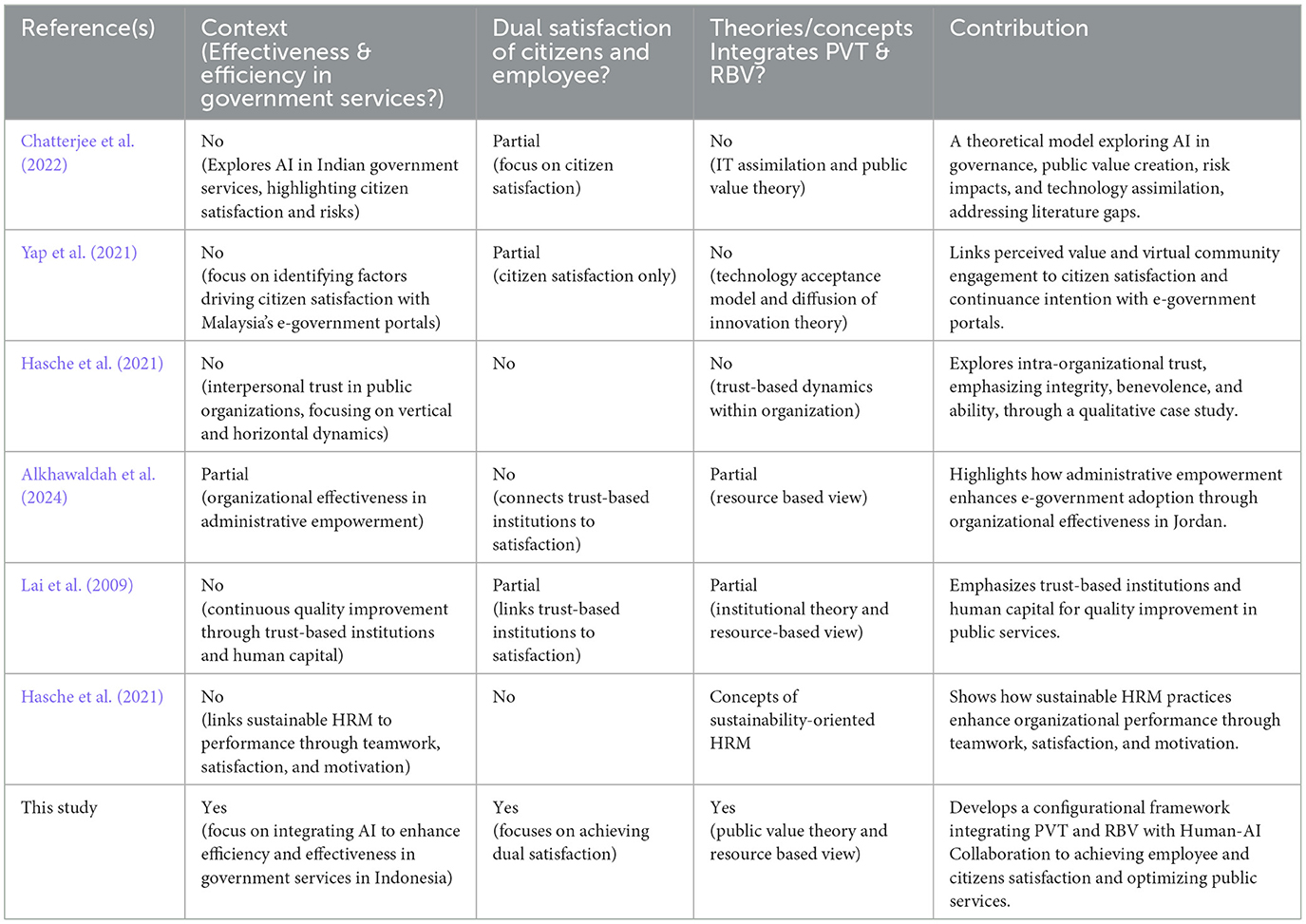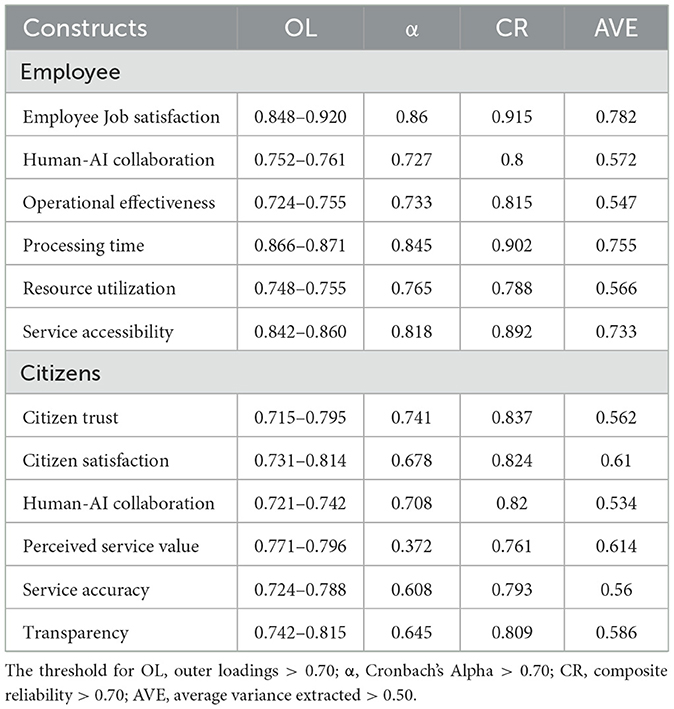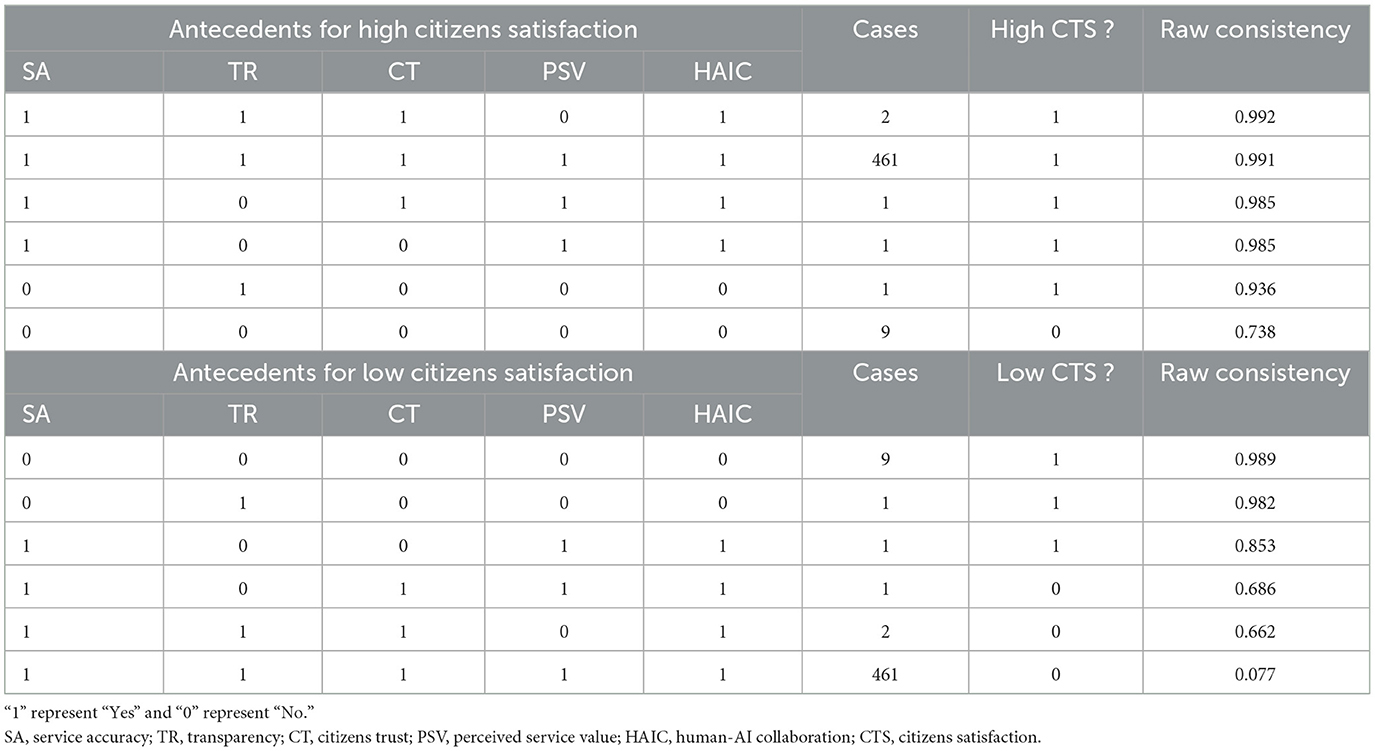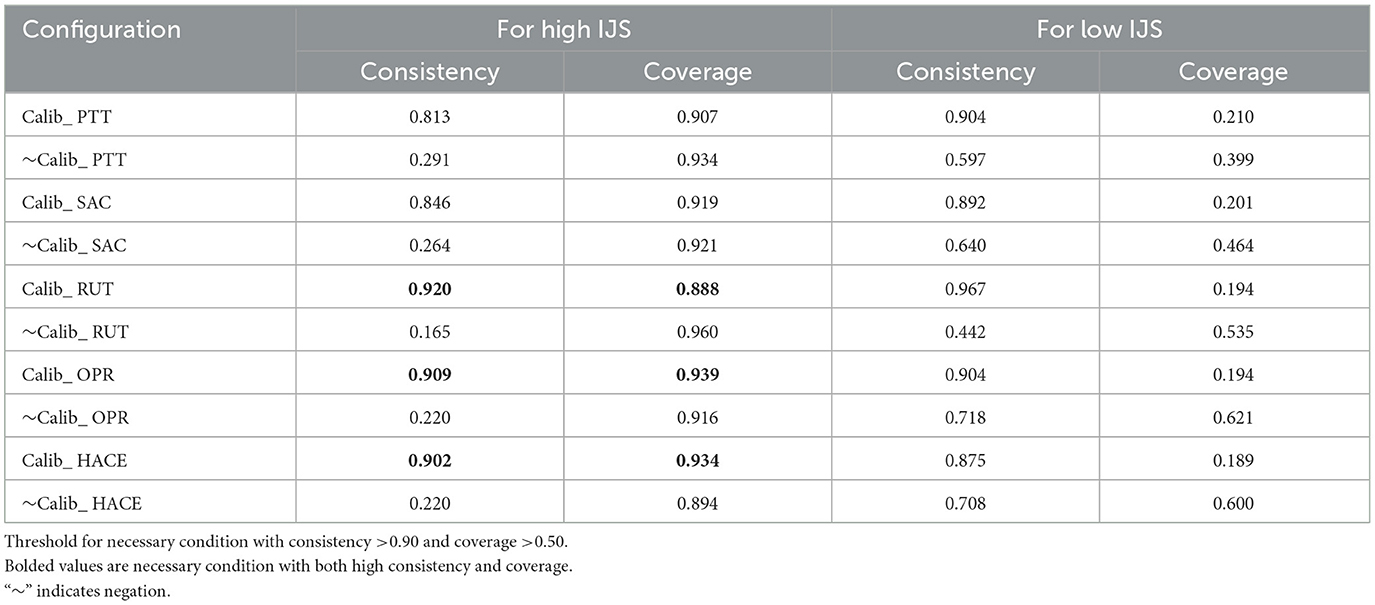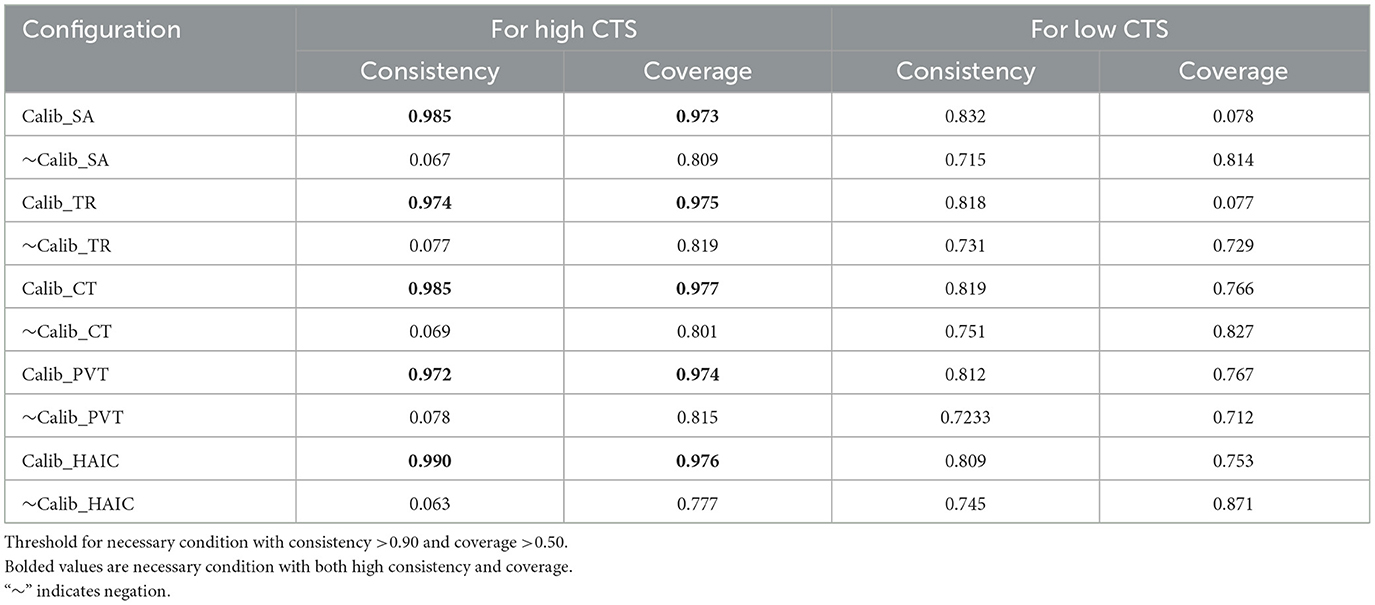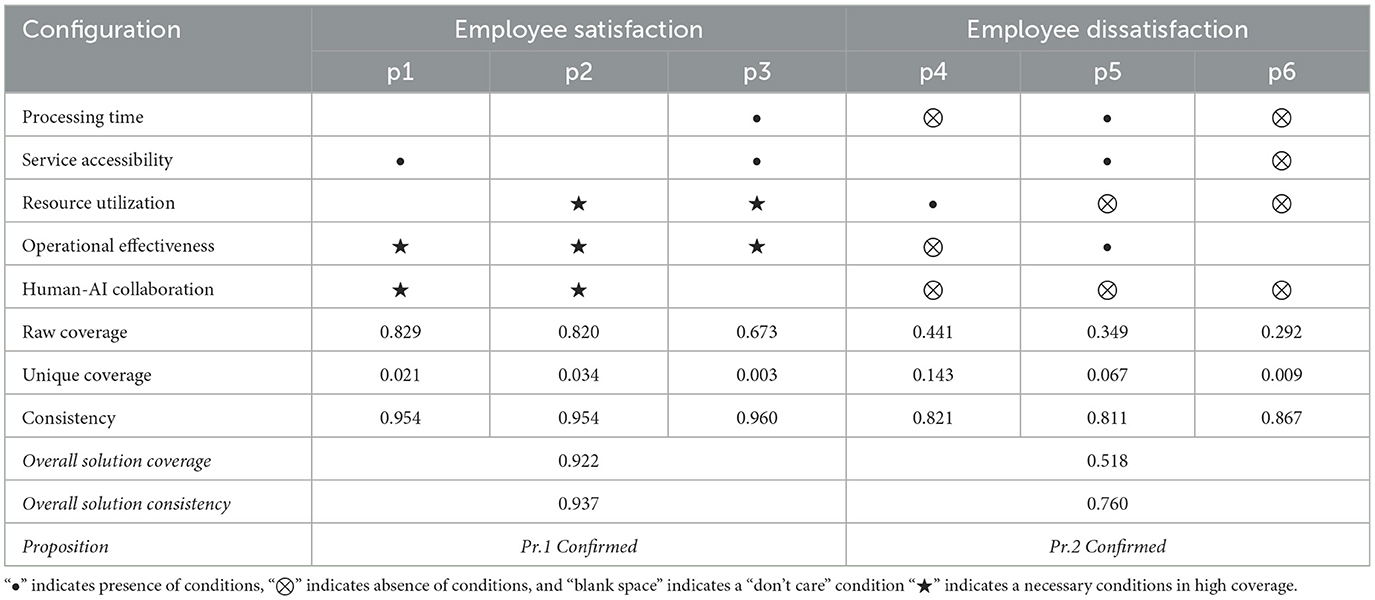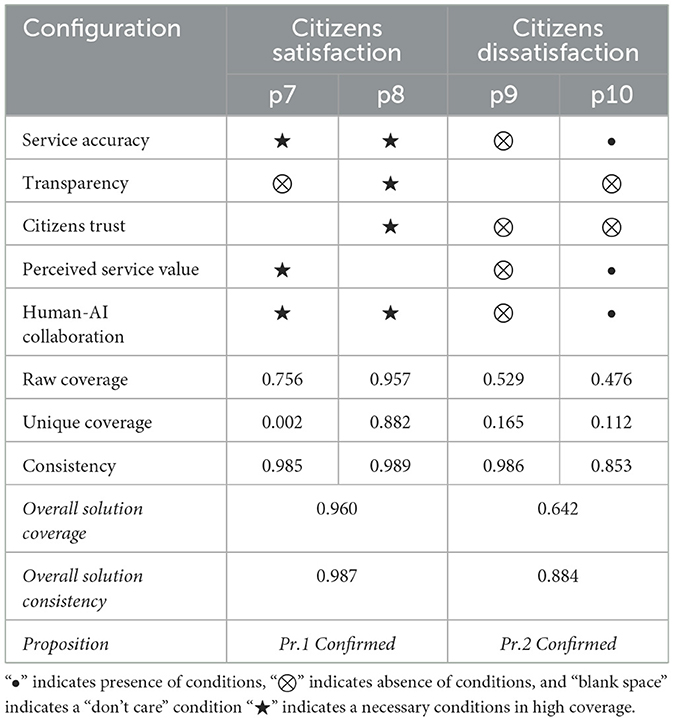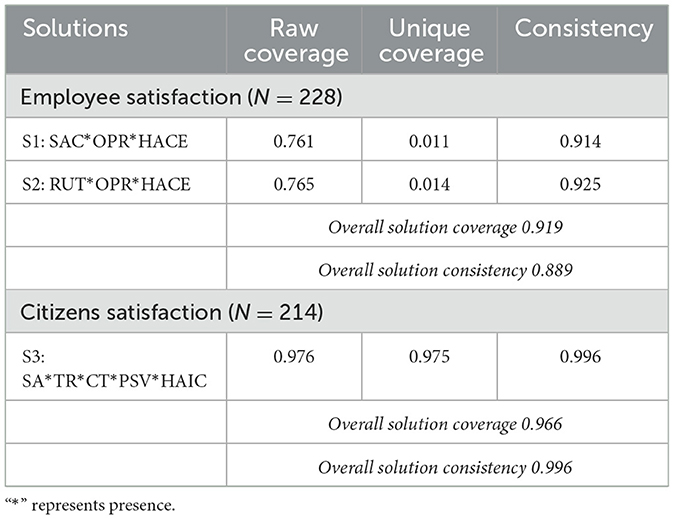- 1Master Program of Public Administration, Universitas Muhammadiyah Palangkaraya, Kalimantan Tengah, Indonesia
- 2Department of Marketing and Logistics Management, College of Management, Chaoyang University of Technology, Taichung, Taiwan
- 3Department of Business Administration, College of Management, Chaoyang University of Technology, Taichung, Taiwan
The integration of AI in public services often poses a paradox: while it can streamline operations, it may simultaneously undermine service effectiveness, ultimately shaping how both citizens and employees perceive service quality. Seeking to address gaps in our understanding of service-related factors in AI-driven settings, this study employs fuzzy-set Qualitative Comparative Analysis (fsQCA) on survey data collected in Indonesia over an 8-month period from 457 citizens and 429 employees. The results reveal six configurations underpinning employee satisfaction and dissatisfaction, alongside four configurations driving citizen satisfaction and dissatisfaction. On the employee side, satisfaction thrives when service accessibility, operational effectiveness, and resource utilization are well-coordinated, whereas dissatisfaction emerges in the presence of fragmented workflows and the lack of key enablers. From the citizen perspective, satisfaction is fueled by trust-building elements such as service accuracy, transparency, and perceived service value, whereas their absence or misalignment leads to dissatisfaction. By unraveling these pathways, this study extends public administration and AI adoption literature, offering insights into how AI-enabled services can balance organizational objectives with user-centric needs. The findings highlight the importance of harnessing AI's efficiencies without sacrificing core service qualities, ultimately guiding strategies to optimize public service outcomes.
1 Introduction
The integration of Artificial Intelligence into public administration has initiated a transformative shift in how governments deliver services to citizens and employees. AI technologies, including machine learning algorithms and automated workflows, promise to enhance efficiency, accuracy, and accessibility in public services (Koskimies and Kinder, 2024). Although such innovations are observed globally, this study focuses on Indonesia—a developing country with a large, diverse population—offering a nuanced perspective on how AI-enabled public services are adopted under resource constraints. Indonesia's status as the fourth most populous nation in the world and its geographic spread across thousands of islands pose unique operational and socio-cultural challenges, making it an ideal setting to investigate how AI can be integrated into public administration effectively. In Indonesia, AI has been adopted across various administrative domains, such as e-governance and public welfare distribution, to address the unique challenges posed by its diverse cultural and geographical landscape. Automation technologies now manage routine tasks like permit approvals and citizen inquiries, significantly reducing delays and improving operational efficiency. Additionally, AI-driven predictive decision-making enables more effective resource allocation, which addresses inefficiencies in public administration. However, while these technologies streamline operations and resource utilization, they also raise critical concerns about fairness, transparency, and inclusivity, reshaping traditional paradigms of governance (Criado and Gil-Garcia, 2019).
Despite these advancements, the adoption of AI in public services is not without resistance. Employees often perceive automation as a threat to job security, while citizens demand transparent systems that ensure fair and equitable treatment (Willems et al., 2023). As noted in the broader context of public sector innovations, bureaucratic structures can lead to inherent resistance to change, and ethical considerations surrounding AI—such as those highlighted in Ashok et al. (2022)—are frequently debated worldwide. These challenges highlight the broader governance complexities associated with integrating AI, particularly its potential impact on human-centric principles such as accountability, inclusivity, and cultural sensitivity. For example, while AI can optimize processes, it risks alienating underserved populations if systems are not designed with fairness and accessibility in mind. As public governance continues to embrace these technologies, it becomes increasingly important to address these concerns. This study examines how AI-enabled public services can achieve dual satisfaction for citizens and employees by aligning operational efficiency with the cultural and societal needs of Indonesian governance.
Governments face a significant effectiveness–efficiency paradox in their AI-enabled public services. While AI systems optimize resource utilization and accelerate processing times, they sometimes fail to address the broader dimensions of service quality, such as trust and inclusivity. For instance, automated decision-making processes may lack the transparency needed to build citizen trust, leading to skepticism and disengagement (Criado and Gil-Garcia, 2019). Similarly, poorly designed AI implementations can exacerbate employee dissatisfaction by introducing new bottlenecks or undermining organizational workflows (Ashok et al., 2022). The findings of this study reveal that achieving dual satisfaction—citizen satisfaction through trust and transparency and employee satisfaction through operational support—requires a detailed approach. By decoding the interplay between efficiency and effectiveness, this research provides insights to resolve the effectiveness–efficiency paradox in public services.
The challenges of AI adoption in public sector stem from fragmented service delivery and insufficient alignment between technology and governance goals. PVT emphasizes the importance of trust, transparency, and inclusivity but lacks guidance on resource optimization, a critical need in resource-constrained settings (Desiere and Struyven, 2021). Similarly, the RBV focuses on operational efficiency but overlooks citizen-centric constructs such as perceived value and trust. These theoretical gaps leave public administrators without a cohesive framework for leveraging AI technologies effectively. This study bridges these gaps by integrating PVT and RBV within a configurational approach, identifying specific pathways to satisfaction that balance citizen needs with organizational priorities.
Despite the growing body of literature on AI in public services, significant gaps remain in understanding how satisfaction outcomes emerge within the broader context of developing countries and beyond. Previous studies often employ linear models like SEM, which fail to capture the complexity of interactions between constructs such as transparency, operational effectiveness, and trust (Prebble, 2018; Pappas and Woodside, 2021). Moreover, the role of Human–AI collaboration in balancing these constructs has been largely overlooked. By applying fsQCA, this study explores the configurational pathways to both high and low satisfaction. This approach offers a deeper understanding of how trust-enabling constructs and operational factors interact to shape satisfaction outcomes in global governance AI-enabled public services.
This study aims to address the dual objectives of achieving citizen satisfaction and employee satisfaction in AI-enabled public services. Specifically, this study seeks to explore how constructs such as trust, transparency, and perceived value influence citizen satisfaction in Indonesian AI-enabled public services, while identifying organizational factors like operational effectiveness and resource utilization that enhance employee satisfaction in Indonesia's AI-driven context. While Indonesia serves as our primary focus, these issues echo in other regions where public organizations grapple with accountability demands and the ethical dimensions of AI deployment (Pappas and Woodside, 2021). By investigating Human–AI collaboration as a mediator, this study contributes to the growing discourse on aligning technological efficiency with human-centric governance.
Guided by the complexities of public services, this study addresses the following research questions: (1) How do trust, transparency, and perceived value influence citizen satisfaction in Indonesian public services? (2) What organizational factors drive employee satisfaction in Indonesia? (3) How does Human-AI collaboration mediate the balance between efficiency and effectiveness? (4) What configurational pathways lead to satisfaction outcomes in Indonesian governance? These questions are integral to decoding the dynamics of AI-enabled governance. This study also directly connects with the study's findings, which reveal distinct pathways to satisfaction, and its implications, which underscore the need for cohesive and inclusive public service strategies.
This study enhances understanding of AI-enabled governance in Indonesia by integrating PVT and RBV to address the effectiveness-efficiency paradox in resource-constrained settings. It extends PVT to emphasize trust and transparency in AI contexts and advances RBV by positioning Human-AI collaboration as a strategic resource. The findings offer practical guidance for policymakers, highlighting the need for AI systems that balance efficiency with citizen-centric outcomes. Trust-enabling factors like transparency and service accuracy boost citizen satisfaction, while operational elements such as resource utilization and Human-AI collaboration improve employee engagement. These insights highlight the importance of aligning technological advancements with human-centric governance to enhance service quality and inclusivity.
2 Literature review
2.1 Previous studies and gaps
Integrating AI into government services to balance effectiveness and efficiency has gained increasing scholarly attention, yet the dual satisfaction of citizens and employees remains underexplored. Existing studies, summarized in Table 1, reveal significant insights but also highlight persistent gaps. Chatterjee et al. (2022) emphasized citizen satisfaction and risk management in Indian AI-enabled services but overlooked employee perspectives and RBV applications. Similarly, Yap et al. (2021) explored citizen satisfaction in Malaysia's e-government portals but failed to address broader organizational effectiveness or dual satisfaction. These limitations point to the need for a holistic framework that captures the interplay between operational efficiency and service quality in public service delivery.
This study extends prior research by integrating PVT and RBV to address dual satisfaction. Unlike Lai et al. (2009) who focused narrowly on trust-based institutions for public service improvement, this study emphasizes configurational pathways that align resource utilization, trust, and transparency to optimize outcomes. Alkhawaldah et al. (2024) linked administrative empowerment to e-government adoption but did not explore how Human-AI collaboration fosters dual satisfaction. By adopting a configurational approach, this study advances a more comprehensive perspective on achieving effectiveness and efficiency in government services, filling critical gaps in the literature.
The methodological innovation of this research lies in using fsQCA to identify the complex, non-linear pathways to high or low satisfaction. Unlike linear models predominantly employed in prior studies, fsQCA captures the equifinal nature of satisfaction, where different combinations of conditions lead to similar outcomes. For example, while prior studies emphasized the role of trust, this research integrates constructs like service accuracy, transparency, and operational effectiveness to uncover distinct pathways to dual satisfaction. This approach ensures that government services are designed to simultaneously empower employees and meet citizen expectations, addressing the effectiveness-efficiency paradox. The study contributes theoretically by extending PVT to emphasize citizen-centric constructs like trust and transparency while advancing RBV by demonstrating how resource optimization aligns with employee satisfaction. By integrating Human-AI collaboration into these frameworks, the study provides a holistic lens to analyze public service dynamics, particularly in resource-constrained environments such as Indonesia. This dual focus not only bridges gaps in existing research but also offers actionable insights for policymakers and public administrators seeking to design AI-driven services that are both effective and efficient.
2.2 The study's focus area and framework
This study integrates PVT and the RBV within a framework of Human-AI Collaboration to decode the pathways to achieving high and low satisfaction among employees and citizens in AI-enabled public services (Figure 1). Public Value Theory emphasizes creating public value by aligning government services with citizen-centric outcomes, including trust, transparency, and satisfaction. It focuses on ensuring that service delivery resonates with citizens' expectations while fostering ethical practices and engagement (Koskimies et al., 2022; Scutella et al., 2024). Although PVT is often associated with effectiveness including outcomes such as equity, inclusivity, and trust—efficiency is also an integral component of public value, as public institutions must judiciously use resources to deliver quality services. On the other hand, RBV highlights the strategic optimization of institutional resources, such as human agents and AI technologies, to improve operational efficiency and contribute to effective service provision without compromising service quality (Barney, 1991; Floridi, 2020). Thus, PVT and RBV are not separate silos but complementary lenses through which both efficiency and effectiveness can be understood as interdependent pillars of public value.
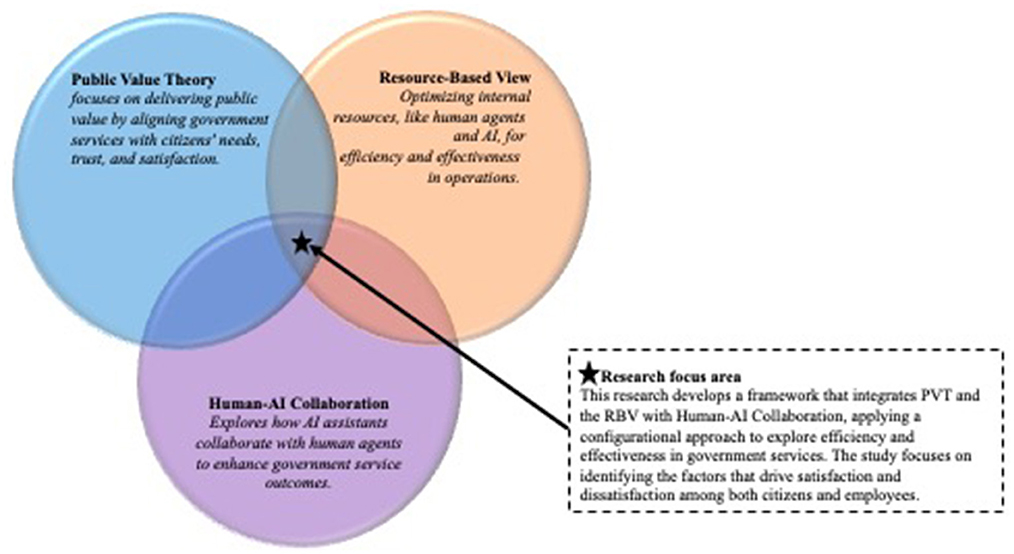
Figure 1. The study's focus area on integrating PVT and RBV with human-AI collaboration to decoding high vs. low employee and citizens (Dis)satisfaction.
At the core of this integration is Human-AI Collaboration, which bridges the strengths of automation and human oversight. AI technologies streamline routine administrative tasks, enhancing accessibility, processing time, and resource utilization (Jiang et al., 2022). Human oversight complements these advancements by providing ethical judgment, trustworthiness, and adaptability to diverse citizen needs (Koskimies and Kinder, 2024). This synergy is particularly critical in the context of Indonesia's public services, where cultural diversity and resource constraints necessitate innovative yet inclusive approaches to service delivery. Human-AI Collaboration not only optimizes service efficiency but also ensures that public value principles are upheld in diverse socio-cultural environments.
Using a configurational approach with fsQCA, this study departs from traditional linear methodologies by capturing the asymmetrical relationships between multiple constructs (Figures 2a, b). For employee satisfaction, critical conditions such as service accessibility, resource utilization, operational effectiveness, and processing time emerge as key determinants, illustrating how the alignment of organizational resources influences workplace satisfaction (Figure 2a). Similarly, for citizen satisfaction, factors like service accuracy, transparency, perceived service value, and trust interplay to create pathways that maximize satisfaction outcomes (Figure 2b). These configurations highlight the equifinal nature of achieving high satisfaction, where different combinations of conditions lead to similar outcomes.
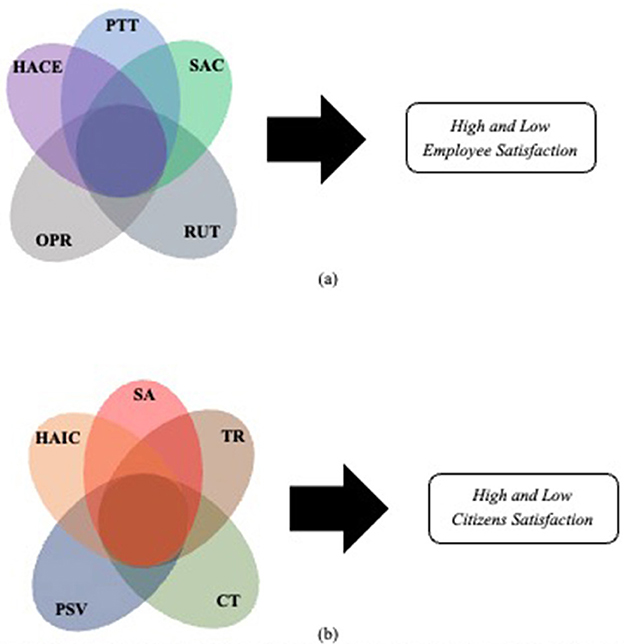
Figure 2. (a, b) The study's configurational paths for high vs. low employee satisfaction and citizens satisfaction. (a) PTT, processing time; SAC, service accessibility; RUT, resource utilization; OPR, operational effectiveness; HACE, human AI collaboration. (b) SA, service accuracy; TR, transparency; CT, citizens trust; PSV, perceived service value; HACE, human Al collaboration.
The configurational framework not only identifies the conditions that foster high satisfaction but also decodes the pathways leading to dissatisfaction. For employees, fragmented operational processes and inefficient resource utilization are key contributors to dissatisfaction, emphasizing the need for cohesive strategies to optimize internal operations. For citizens, dissatisfaction arises from the absence of trust-enabling constructs like transparency and service accuracy, pointing to the critical role of trust in fostering public engagement. The visualized configurational pathways (Figures 2a, b) underscore the interplay of these constructs.
By integrating PVT and RBV through Human-AI Collaboration and employing fsQCA, this study contributes to advancing theoretical and practical understanding of AI-enabled public services. The findings provide a roadmap for public administrators to balance operational efficiency and citizen-centric effectiveness, addressing the longstanding effectiveness-efficiency paradox. Figures 1, 2 not only demonstrate the theoretical underpinnings but also visualize the multi-dimensional framework.
2.3 Effectiveness dimensions from public value theory
Public Value Theory was introduced by Moore (1997) and expanded by Benington and Moore (2010), positions public services as drivers of societal wellbeing by aligning governance outcomes with citizen needs and democratic values. It emphasizes the role of public managers as stewards of trust, accountability, and transparency while promoting equitable resource distribution (Prebble, 2018; Fukumoto and Bozeman, 2019). PVT has been widely used to evaluate public sector initiatives, offering tools to assess how fiscal policies and programmatic decisions create societal benefits (Kalambokidis, 2014; Williams and Shearer, 2011). With public service delivery increasingly adopting digital technologies, PVT provides a vital framework for assessing AI integration in public administration, focusing on how these technologies can uphold inclusivity, fairness, and trust (Criado and Gil-Garcia, 2019; Hong and Lee, 2023).
One of the primary dimensions of PVT in the AI-enabled public service context is service accuracy, which represents the ability to deliver precise and consistent outcomes that align with citizen expectations. Accurate service delivery reduces errors and delays, thereby fostering confidence in the government's capacity to provide fair and efficient services (Kulal et al., 2024; Chen et al., 2021). For example, AI technologies in public services such as permit processing or social benefit allocation enhance both efficiency and reliability by minimizing administrative bottlenecks and ensuring fair treatment. However, service accuracy alone cannot address broader concerns around equity and inclusivity. It requires an ethical framework to ensure that accuracy does not exacerbate systemic inequalities or biases, thereby maintaining public trust and upholding democratic principles (Desiere and Struyven, 2021).
Transparency is a fundamental element of effective public service delivery within the PVT framework. It enables citizens to understand decision-making processes, fostering trust in the system's fairness and accountability (De Fine Licht and de Fine Licht, 2020). In AI-driven services, transparency mitigates the opacity of algorithmic decisions by offering clear, accessible explanations of operational processes, thereby reducing uncertainty and building public confidence (Fatima et al., 2022; Wang et al., 2023). Moreover, transparency promotes inclusivity by ensuring that all citizens, regardless of socioeconomic or cultural background, have equal access to resources and a clear understanding of their entitlements (Willems et al., 2022). Striking a balance is essential, as excessive detail can overwhelm users, while insufficient transparency risks eroding trust.
Citizen trust is a key foundation of effective public services and emerges from the interaction of accuracy, transparency, and ethical governance. Trust is not just the result of reliable service delivery but also shapes how citizens perceive fairness and inclusivity in public systems (Robles and Mallinson, 2023). In AI-enabled services, building trust requires addressing risks related to data privacy and algorithmic bias (Kleizen et al., 2023; Wang et al., 2021). Trust enhances the value of public services by ensuring citizens view these systems as equitable and responsive to their needs (Yigitcanlar et al., 2023). Strengthening trust requires active citizen engagement and clear communication about service capabilities alongside ethical oversight of AI implementation to align with the principles of PVT in the digital era.
2.4 Efficiency dimensions from resource-based view
The RBV provides a vital framework for understanding how strategic resource allocation improves public service efficiency. Introduced by Wernerfelt (1984) and Barney (1991), RBV highlights the importance of leveraging assets like expertise, infrastructure, and institutional knowledge to achieve sustainable operational advantages. In AI-enabled public services, RBV emphasizes the potential of AI to optimize resource use, improve workflows, and reduce inefficiencies (Wang et al., 2023; Mikhaylov et al., 2018). The effectiveness of AI systems relies on their integration with human expertise and alignment with institutional objectives to ensure technological capabilities support governance goals while addressing accountability and public trust.
Processing time represents a critical dimension of operational effectiveness under the RBV framework. AI-driven systems significantly reduce processing delays by enabling rapid data analysis and automated decision-making, allowing public services to meet growing demands without proportionately increasing resources (Yin et al., 2023; Liu et al., 2020). By enhancing the speed and scalability of service delivery, AI contributes to operational reliability and responsiveness, thereby elevating citizens' perceptions of government efficiency. Moreover, optimized processing times alleviate the workload for employees, enabling them to focus on higher-value tasks, which enhances job satisfaction and contributes to organizational effectiveness. This capacity to maintain high service standards while minimizing delays highlights the transformative potential of AI in public administration.
Service accessibility is another cornerstone of operational efficiency, as it ensures inclusivity and ease of use in public service systems. AI technologies, such as natural language processing and adaptive interfaces, make government services more accessible to diverse populations, including individuals with disabilities (Hong and Lee, 2023; Kim et al., 2023). For employees, streamlined e-government systems enhance productivity by providing secure and transparent platforms for service delivery, fostering a supportive work environment that drives satisfaction and reliability (Chowdhury et al., 2022). However, addressing potential inequities in access and accountability requires robust governance frameworks to ensure that AI implementation aligns with principles of fairness and inclusivity. By overcoming these challenges, service accessibility becomes a vital enabler of both employee efficiency and citizen satisfaction.
Efficient resource utilization is essential for improving the operational effectiveness of AI-driven public services. AI reallocates resources to high-priority tasks and eliminates redundancies, enabling employees to focus on strategic roles that add greater value to public administration (Henkel et al., 2020; Mukherjee, 2022). Tools like predictive analytics and workflow optimization software support proactive management, reduce bottlenecks, and enhance collaboration between human and AI systems (Chowdhury et al., 2022). However, successful implementation must address potential stress linked to AI augmentation and ensure employee wellbeing (Young et al., 2019; Olan et al., 2022). Strategic resource utilization is central to leveraging AI for operational excellence and fostering a culture of efficiency in public services.
2.5 Human-AI collaboration
Human-AI collaboration introduces a transformative approach in public services by merging AI's computational power with human judgment, empathy, and adaptability. While AI efficiently processes large datasets, automates routine tasks, and ensures rapid decision-making, humans contribute ethical oversight, contextual understanding, and adaptability to diverse citizen needs (Jiang et al., 2022; Le et al., 2023). This synergy mitigates the “black box” nature of AI, enhances transparency, and delivers personalized services that build trust and inclusivity in public administration (Floridi, 2020; Alon-Barkat and Busuioc, 2023). By aligning AI's strengths with human intervention, this collaboration addresses the efficiency-effectiveness paradox inherent in public service delivery.
Operational efficiency benefits significantly from this partnership, particularly in processing time, service accessibility, and resource utilization. AI reduces delays, optimizes workflows, and ensures scalability, enabling organizations to meet growing demands effectively (Cranefield et al., 2023; Noor et al., 2022). Meanwhile, human oversight ensures transparency and equity, fostering personalized and inclusive services that align with organizational goals (Li et al., 2023). This hybrid approach supports seamless integration of AI into public services, maintaining high-quality delivery while addressing challenges like automation bias and information asymmetry (Vassilakopoulou et al., 2023).
Efficient resource utilization exemplifies the value of Human-AI collaboration, as AI automates repetitive tasks and optimizes operational capacity, freeing employees to focus on strategic roles (Chowdhury et al., 2022). At the same time, human involvement ensures fairness and accountability, particularly in decision-making processes. This balance addresses overreliance on AI while fostering employee satisfaction and maintaining citizen trust (Flathmann et al., 2023). By leveraging both AI's precision and human adaptability, this collaboration enables public services to achieve sustainable efficiency and effectiveness, ensuring responsive, equitable, and trustworthy governance.
2.6 Employee and citizens satisfaction
Integrating citizen and employee satisfaction is crucial for achieving effectiveness and efficiency in AI-enabled public services. Citizen satisfaction reflects the quality, accessibility, and responsiveness of services, serving as a core element of public value. Transparent and ethical AI governance builds trust by addressing concerns about bias, data security, and privacy through clear communication and algorithmic fairness (Floridi, 2020; Prokop and Tepe, 2022). AI-driven personalization enhances inclusivity by tailoring services to individual needs and increasing perceived service value (Koskimies et al., 2022; Kumar et al., 2021). Simplifying processes and ensuring equitable participation through inclusive design strengthens citizen engagement with public agencies, laying the groundwork for long-term trust and accountability.
On the employee side, job satisfaction reflects how effectively AI technologies are integrated into workplace processes and organizational practices. AI enhances operational efficiency by automating repetitive tasks, enabling employees to concentrate on more strategic functions, which increases their engagement and productivity (Marikyan et al., 2022; He et al., 2023). However, the integration of AI must be carefully managed to avoid negative outcomes such as digital overload or reduced autonomy. Leadership plays a critical role in harmonizing technological advancements with employee wellbeing, fostering adaptability and resilience in a rapidly evolving digital environment (Fleischer and Wanckel, 2024). Empowering employees with AI tools not only improve workflow efficiency but also aligns their roles with organizational goals, creating a supportive environment that drives both satisfaction and high performance.
The relationship between citizen and employee satisfaction is mutually reinforcing. Positive citizen experiences validate employees' efforts, enhancing their sense of purpose and motivation (Prysmakova, 2021). When citizens express satisfaction with AI-enabled services like personalized assistance or faster processing, employees feel valued and appreciated, boosting morale and pride (Chen et al., 2021). In turn, motivated employees deliver higher-quality services, shaping citizens' perceptions of government as efficient and responsive. This dynamic foster a cycle of trust and engagement, enabling both citizens and employees to thrive in an environment defined by transparency, inclusivity, and collaboration.
3 Proposition development
Achieving citizen and employee satisfaction in AI-enabled public services requires a nuanced understanding of the configurational pathways that foster or hinder these outcomes. Existing research, such as Criado and Gil-Garcia (2019) and Scutella et al. (2024), has predominantly relied on linear models like SEM to examine satisfaction, which often oversimplifies the complex relationships among constructs. These models overlook the equifinality and asymmetrical nature of satisfaction, where multiple, context-specific configurations of factors lead to similar outcomes. By integrating PVT and the RBV with a configurational methodology like fsQCA, this study advances the theoretical understanding of how citizen-centric effectiveness and operational efficiency can coexist. Specifically, it highlights the interplay between constructs such as trust, transparency, and operational resources, offering a more comprehensive perspective on public service optimization.
This study bridges critical gaps in the existing literature by addressing the multi-dimensional and asymmetrical nature of satisfaction outcomes in AI-enabled public services. Previous studies have emphasized the significance of trust and operational efficiency, but these factors are often examined in isolation without considering their dynamic interplay or the diverse pathways that lead to similar outcomes (Prebble, 2018; Kalambokidis, 2014). While high citizen satisfaction might result from trust and service accuracy, dissatisfaction often arises from fragmented service delivery or the absence of key constructs like transparency (Robles and Mallinson, 2023). Similarly, employee satisfaction may depend on effective resource utilization and operational efficiency but is undermined by misaligned or inefficient systems. By leveraging fsQCA, this study decodes these complex, non-linear pathways, uncovering how the presence or absence of certain conditions can shape satisfaction outcomes.
In analyzing these pathways, the study reveals that satisfaction is rarely driven by a single factor but rather by configurations of complementary conditions. For citizens, constructs such as trust, transparency, and service accuracy are critical for fostering satisfaction, yet these factors must align cohesively to create a robust service experience (Benington and Moore, 2010; Willems et al., 2022). In contrast, for employees, operational effectiveness and resource utilization are essential but need to be paired with service accessibility to drive engagement and workplace satisfaction (Yin et al., 2023; Liu et al., 2020). This configurational lens challenges the traditional one-size-fits-all approach, highlighting how tailored combinations of constructs address unique satisfaction drivers for both groups. Such findings underscore the need for public administrators to adopt a holistic perspective when designing AI-enabled public services.
The configurational methodology employed in this research provides new insights into how satisfaction is achieved through cohesive alignments of key constructs. High citizen satisfaction, for instance, emerges from pathways where trust-building mechanisms such as transparency and service accuracy are effectively integrated. Conversely, dissatisfaction is rooted in fragmented conditions, where critical factors like trust or transparency are absent, eroding public confidence and engagement (Criado and Gil-Garcia, 2019; Desiere and Struyven, 2021). Similarly, employee satisfaction is shaped by the alignment of operational efficiency, resource optimization, and workplace support systems, while dissatisfaction arises from a lack of cohesion in these areas. These findings advance the theoretical understanding of satisfaction as a multi-dimensional construct, shaped by the presence and alignment of enabling conditions.
Through its propositions, this study articulates the necessity and sufficiency of specific conditions in driving satisfaction, emphasizing the equifinality of configurational pathways. For example, while service accuracy and trust are essential for citizen satisfaction, they must be combined with transparency to foster long-term public engagement (Barney, 1991; Robles and Mallinson, 2023). Similarly, for employees, resource utilization and operational effectiveness must align with accessible service delivery frameworks to sustain high workplace satisfaction (Chowdhury et al., 2022; Vassilakopoulou et al., 2023). These propositions challenge oversimplified models of satisfaction, advocating for a nuanced, tailored approach that recognizes the interplay of multiple constructs in shaping outcomes.
Ultimately, the propositions derived from this study provide a robust foundation for advancing theoretical and practical understanding of AI-enabled public services. By integrating PVT and RBV with fsQCA, the study highlights the interplay between trust, transparency, and operational efficiency to provide a comprehensive framework for addressing the effectiveness-efficiency paradox. These findings guide empirical testing and offer practical insights for public administrators seeking to optimize service delivery while balancing the diverse needs of citizens and employees. Such an approach ensures that public services remain responsive, equitable, and sustainable in the context of rapidly evolving technological environments. Therefore, the following propositions were proposed:
Proposition 1: No single presence condition—whether it be processing time, resource utilization, or service accessibility—is sufficient to achieve high employee satisfaction in AI-enabled public services.
Proposition 2: No single absence condition—whether it be processing time, resource utilization, or service accessibility—is sufficient to explain low employee satisfaction in AI-enabled public services.
Proposition 3: No single presence condition—whether it be service accuracy, transparency, or trust—is sufficient to achieve high citizen satisfaction in AI-enabled public services.
Proposition 4: No single absence condition—whether it be service accuracy, transparency, or trust—is sufficient to explain low citizen satisfaction in AI-enabled public services.
4 Method
4.1 Research context
Indonesia's vast and diverse population, spread across thousands of islands, presents unique challenges for public administration. Traditional systems often struggle to provide services that are accessible, transparent, and efficient, particularly under resource constraints. To address these challenges, artificial intelligence technologies—such as automated identity verification, citizen engagement platforms, and data-driven decision tools—are being implemented to enhance service delivery (Koskimies and Kinder, 2024; Floridi, 2020). These technologies improve speed, accuracy, and inclusivity, but they cannot address all issues alone. Questions of fairness, ethics, and trust remain critical. Human-AI collaboration bridges this gap by combining AI's efficiency with human judgment, ensuring services are fair, culturally sensitive, and accountable. This integration reduces inefficiencies and builds trust while fostering inclusivity. This study examines how balancing AI and human oversight influences key outcomes, such as employee and citizen satisfaction, providing insights into optimizing public services to align with stakeholder expectations in Indonesia's complex administrative context (Koskimies and Kinder, 2024; Scutella et al., 2024).
4.2 Operationalization and measurement items
4.2.1 Service accuracy
Service accuracy describes how well AI-powered public services can deliver reliable, precise, and contextually appropriate responses to meet users' diverse needs. The idea is inspired by Wagenheim and Reurink (1991), who stressed the importance of minimizing errors through accurate task completion on the first attempt, and Vigoda (2000), who highlighted the need for responses that align with the context of user expectations. Drawing from Chan et al. (2021), this variable is measured by assessing both the technical accuracy of the service and its ability to respond appropriately to specific user situations.
4.2.2 Transparency
Transparency reflects how well the system reduces information gaps by ensuring the public gains a clear understanding of ongoing processes. This concept aligns with Heald (2006) and Florini (2007), who emphasize the importance of information disclosure in promoting public participation and strengthening accountability. Similarly, Grimmelikhuijsen (2012) highlights the role of transparency in enabling citizens to monitor and evaluate service performance objectively. Adapted from Chen (2021), this study measures transparency by assessing the extent to which AI systems can provide relevant updates, explain decision impacts, and build trust by minimizing information gaps between the government and the public.
4.2.3 Citizens trust
Bouckaert and Van de Walle (2003) emphasize that trust strengthens when government actions demonstrate fairness, consistency, and responsiveness, while Mansoor (2021) highlights the importance of meeting citizens' expectations in building trust. In this study, citizens' trust refers to the belief that AI-driven public services can effectively provide dependable, efficient, and citizen-centered results. To assess this, indicators adapted from Chen et al. (2021) focus on service reliability, efficiency, and alignment with public welfare.
4.2.4 Public service value
According to Moore (1997) public service value reflects the shared expectations citizens have regarding how well government services perform in meeting their needs. Meanwhile, Pandey (2024) highlights public service value as a quantifiable result derived from the quality, efficiency, and effectiveness of public service delivery. In this study, public service value is measured using dimensions adapted from Li and Shang (2020), which include time savings, the justification of government expenditure, and the encouragement of continued service use.
4.2.5 Citizens satisfaction
Citizen satisfaction refers to how individuals assess the quality and reliability of AI-powered public services based on both rational judgments and emotional experiences. It captures the extent to which services meet public expectations by delivering efficient, dependable, and beneficial outcomes. Drawing from Wang et al. (2021), satisfaction is measured using indicators such as perceived service quality, trust in service delivery, and the benefits received from the services provided.
4.2.6 Processing time
Processing time highlights the system's ability to minimize delays and provide real-time updates for effective task management. Mishra and Varma (2020) describe it as the duration a system requires to process service requests, while Véronneau and Cimon (2007) emphasize its role in facilitating timely decision-making. To assess this variable, measurement items adapted from Alanezi et al. (2012) evaluate task completion speed, process time updates, and the overall efficiency of AI tools in handling public service operations.
4.2.7 Service accessibility
Service accessibility describes the extent to which AI-powered public services facilitate smooth, inclusive, and user-friendly access to public resources. Wixom and Todd (2005) emphasize the importance of technology in simplifying access to services, while Osei-Kojo (2017) highlights the role of digital platforms in improving public sector inclusivity. To assess this concept, measurement items adapted from Wixom and Todd (2005) evaluate factors such as ease of use, service availability, and the convenience of accessing public services through AI-based tools.
4.2.8 Resource utilization
Resource utilization refers to how AI-powered public services manage and apply resources strategically to ensure task efficiency and operational effectiveness. Javed et al. (2020) describe it as achieving maximum results with minimal input, while Wang and Zhao (2024) emphasize the importance of integrating resources for adaptability and long-term performance. Similarly, Wan et al. (2023) stress its strategic importance in reaching desired outcomes. To assess this concept, measurement items adapted from Caldwell and Hayes (2007) evaluate how AI contributes to resource efficiency, task execution quality, and the overall effectiveness of public service operations.
4.2.9 Operational effectiveness
In this study, operational effectiveness describes the ability of AI-powered public services to manage resources wisely, produce consistent results, and adjust to shifting demands. Evans and Lindsay (2011) emphasize the importance of surpassing public expectations, while Santa et al. (2019) highlight critical elements such as accuracy, speed, cost efficiency, and adaptability in public service delivery. To evaluate this variable, measurement items adapted from Santa et al. (2019) focus on how AI systems contribute to improving service reliability, shortening response times, and maintaining cost-effective, flexible service operations.
4.2.10 Employee job satisfaction
Employee job satisfaction refers to the sense of fulfillment and support employees experience in their roles, particularly when using AI tools to assist their tasks. Harter et al. (2002) describe job satisfaction as employees' attitudes toward their work, while Addis et al. (2019) emphasize the positive impact of AI tools in improving job experiences and workplace perceptions. To measure this variable, indicators adapted from Addis et al. (2019) examine employees‘ satisfaction with AI-supported tasks, their sense of job fulfillment, and how well they feel supported by the organization.
4.2.11 Human-AI collaboration
In this study, Human-AI collaboration emphasizes how cooperative interactions between AI systems and individuals can improve task performance, service quality, and operational reliability. Tan et al. (2023) and Yue and Li (2023) describe this interaction as a partnership where both parties contribute unique capabilities to reach common goals. FTo measure this concept, indicators adapted from Hou et al. (2023) and Zhang et al. (2024) assess factors such as trust in the system, efficiency in task completion, and the seamless integration of AI in public service operations.
4.3 Sampling technique, profile, and data collection procedures
This study collected data through an online survey targeting citizens and government employees engaged with AI-powered public services in Indonesia. Participants were selected using purposive sampling to ensure their experiences aligned with the research objectives. Eligible respondents included individuals aged 18 or older who had interacted with AI-enabled services or tools. The survey, hosted on Google Forms, was distributed through government networks, social media, and public service email lists. It covered informed consent, demographic details, AI usage patterns, and key constructs measured on a 7-point Likert scale. Validated by experts and translated into Indonesian, the survey emphasized confidentiality and the right to withdraw. Over 8 months, 886 responses were collected (457 citizens and 429 employees), providing critical insights into how AI integration enhances public service efficiency, transparency, trust, and satisfaction.
The citizen demographic highlights a diverse and dynamic population engaging with AI-enabled public services. With females slightly outnumbering males (57 vs. 43%) and a dominant age group of 26–35 years (43%), the data underscores a young, middle-aged demographic. Educational attainment skews toward high school graduates (52%), followed by bachelor's degree holders (43%), indicating moderate levels of formal education. Occupation patterns show private company employees and entrepreneurs leading (29% each), with notable contributions from university students (23%) and government employees (18%), reflecting a range of economic and social backgrounds. Income distribution suggests economic diversity, with a majority earning IDR 3,000,001–5,000,000 (36%), and a strong urban representation (60%) highlights accessibility challenges for rural citizens (40%), emphasizing a potential gap in service delivery equity.
The employee profile reveals a balanced and youthful workforce, with females representing 54% and 76% of employees aged 26–35 years. Public service providers (45%) and administrative staff (34%) dominate roles, while IT personnel remain underrepresented (6%), signaling potential skill gaps in technical expertise. The reliance on chatbots (48%) and AI-based administrative tools (38%) demonstrates a significant shift toward automation, yet only 13% use AI for decision support, suggesting room for further technological integration. Notably, 71% of employees have 1–3 years of service, reflecting rapid workforce turnover and adaptation to evolving public service technologies.
4.4 Analysis technique
This study applies fuzzy-set qualitative comparative analysis (fsQCA) using fsQCA 4.1 to identify the pathways leading to high and low employee satisfaction and citizen satisfaction in AI-enabled public services. FsQCA is particularly suited for analyzing complex, non-linear interactions among multiple variables, making it an effective tool for examining constructs such as human-AI collaboration, operational effectiveness, resource utilization, and service accessibility. Unlike linear methods such as regression or structural equation modeling (SEM), fsQCA captures equifinality (different combinations of conditions producing similar outcomes) and asymmetry (the pathways to high satisfaction can differ fundamentally from the pathways to low satisfaction). Fiss (2011) and Ragin (2008) underscore that this configurational approach is invaluable when exploring multiple causal patterns, which are often present in multi-faceted phenomena such as public service delivery.
The analysis begins with calibration, transforming responses from a 7-point Likert scale into fuzzy sets using thresholds for full membership, non-membership, and the crossover point, following guidelines from Pappas and Woodside (2021) and Ragin (2023). These calibrated values serve as the basis for generating a truth table, which systematically identifies configurations of causal conditions influencing satisfaction outcomes. One key advantage of fsQCA is its ability to address the heterogeneity within samples—rather than forcing a single “best-fit” model, fsQCA allows for multiple causal pathways to emerge, aligning with the theoretical premise that different AI-enabled contexts (e.g., variations in organizational readiness or user demographics) may yield different roads to satisfaction.
The fsQCA analysis evaluates necessity and sufficiency to uncover the combinations of conditions that lead to high vs. low satisfaction among employees and citizens. Metrics such as consistency, raw coverage, and unique coverage validate the identified pathways, ensuring robust alignment with the study's theoretical framework. In contrast to SEM or linear regression, which typically treat relationships as uniform across all observations, fsQCA focuses on case-based patterns, offering nuanced insights into why certain public service outcomes occur under specific configurations of technology, resources, and trust-related factors (see Pappas and Woodside, 2021; Ragin, 2023). The findings reveal distinct drivers of satisfaction in AI-enabled public services, including the roles of processing time, transparency, and service quality, and how these factors combine to influence satisfaction outcomes. By distinguishing the pathways to both high and low satisfaction, this study provides rich, case-sensitive insights for optimizing AI-enabled public service delivery.
5 Result
5.1 Common method variance
Common method variance was assessed to ensure the integrity of the self-reported questionnaire data. Harman's single-factor test, conducted in SPSS 26, revealed that eigenvalues for employees ranged from 1.330 to 9.281 and for citizens from 1.259 to 9.182, with no single factor exceeding the 50% variance threshold (Baumgartner et al., 2021). Additionally, variance inflation factor analysis generated from SmartPLS-4 showed values between 1.000 and 2.334 for employees and 1.000 and 1.608 for citizens, indicating no multicollinearity concerns. These analyses confirm that the dataset is reliable and unaffected by significant CMV issues.
5.2 Validity and reliability assessment
The measurement model's reliability and validity were assessed for both employee and citizen datasets using SmartPLS 4.0, demonstrating its robustness shown in Table 2. OL exceeded the recommended threshold of 0.70, confirming strong item reliability across all constructs. Internal consistency was validated with CA and CR values above 0.70 for both datasets. Additionally, AVE values surpassed the 0.50 benchmark, ensuring convergent validity. These results confirm the reliability and validity of the measurement model across both datasets, establishing a solid foundation for further structural equation modeling and hypothesis testing (Hair et al., 2017).
5.3 Calibration selection and truth table
This study employs fsQCA to uncover pathways to high and low levels of employee satisfaction and citizen satisfaction in AI-enabled public services. Responses from a 7-point Likert scale were calibrated into fuzzy sets with thresholds of “6” for full membership, “4” as the crossover point, and “2” for full non-membership, based on established guidelines (Pappas and Woodside, 2021). The calibrated data enabled the creation of truth tables, which identified causal configurations of key antecedents such as processing time, service accessibility, and human-AI collaboration for employees, as well as service accuracy, transparency, and citizen trust for citizens. The Tables 3, 4 provided insights into how combinations of factors influence satisfaction outcomes, forming the basis for further analysis.
In Table 3, for high employee satisfaction, eleven configurations were identified with raw consistency values ranging from 0.939 to 1.000. For instance, a configuration with perfect consistency included the presence of service accessibility and operational effectiveness, paired with the absence of resource utilization. This highlights how efficient AI collaboration and accessible services drive satisfaction even when resources are not fully optimized. Another pathway, with a consistency of 0.990, demonstrated the importance of balancing resource utilization and operational efficiency to achieve high satisfaction. These findings underscore the importance of integrating multiple complementary antecedents to create optimal conditions for employee satisfaction. For low employee satisfaction, fragmented and inconsistent pathways were observed, with raw consistency values as low as 0.229. One configuration included the absence of service accessibility and operational effectiveness, paired with the presence of resource utilization, emphasizing the negative impact of inaccessible and inefficient systems. Another configuration demonstrated how the absence of human-AI collaboration contributes to dissatisfaction, even when other factors are present. These results highlight how misaligned or absent conditions undermine employee satisfaction and reveal critical areas for improvement in AI-enabled public services.
In Table 4, for high citizen satisfaction, six configurations were identified with raw consistency values ranging from 0.738 to 0.992. One notable configuration achieving a consistency of 0.992 highlighted the presence of service accuracy, transparency, and human-AI collaboration, while perceived service value was absent. This result demonstrates that when core service dimensions such as accuracy and transparency are well-integrated, high satisfaction can still be achieved even in the absence of value perceptions. Another high-satisfaction pathway, with a consistency of 0.985, emphasized the importance of citizen trust, service accuracy, and human-AI collaboration, underlining trust as a central driver of satisfaction in public services. Conversely, low citizen satisfaction configurations reflected a more fragmented nature with consistency scores ranging from 0.077 to 0.989. For example, a pathway with 0.989 consistency indicated the absence of all key antecedents—service accuracy, transparency, citizen trust, perceived service value, and human-AI collaboration—leading to dissatisfaction. Another pathway, with a consistency of 0.853, highlighted the absence of transparency and service accuracy despite the presence of perceived service value and human-AI collaboration, showing how a lack of critical service elements can offset the benefits of other factors. These low-satisfaction configurations underscore the need for cohesive and aligned service delivery mechanisms to foster citizen satisfaction.
This analysis highlights the configurational nature of satisfaction outcomes in AI-enabled public services by comparing pathways to high and low satisfaction. High satisfaction arises from cohesive alignments of key factors such as service quality, operational efficiency, and trust, while low satisfaction stems from fragmented or missing alignments. These findings offer strategic insights for public service organizations to improve satisfaction by focusing on critical areas like service accessibility, transparency, and AI collaboration. The results also stress the need to address misalignments to mitigate dissatisfaction, providing a comprehensive framework for enhancing both employee and citizen satisfaction in AI-driven environments.
5.4 Necessary condition analysis
Levels of employee satisfaction and citizen satisfaction in AI-enabled public services shown in Table 5. Using thresholds of consistency >0.90 and coverage >0.50 (Pappas and Woodside, 2021), the results reveal key conditions required for positive outcomes. For high employee satisfaction, constructs such as resource utilization (consistency: 0.920, coverage: 0.888) and operational effectiveness (consistency: 0.909, coverage: 0.939) emerge as indispensable drivers. Human-AI collaboration also plays a pivotal role, achieving consistency and coverage values of 0.902 and 0.934, respectively, underscoring its importance in fostering employee engagement and satisfaction within AI-enabled service environments. These findings highlight that high satisfaction is driven by cohesive and aligned configurations of critical factors.
In contrast, in Table 6, low employee satisfaction arises from fragmented pathways and the absence of key antecedents. For instance, the negation of resource utilization (~Calib_RUT: consistency: 0.442, coverage: 0.535) and operational effectiveness (~Calib_OPR: consistency: 0.718, coverage: 0.621) significantly contributes to dissatisfaction. These results suggest that when essential elements like operational efficiency and resource optimization are absent, employee satisfaction deteriorates even if other constructs are present. This fragmented nature of low satisfaction pathways underscores the importance of holistic alignment across constructs, as the absence of critical drivers disrupts the overall satisfaction framework.
For citizen satisfaction, high satisfaction pathways are characterized by strong alignments of trust-related and service quality constructs. Service accuracy (consistency: 0.985, coverage: 0.973) and transparency (consistency: 0.974, coverage: 0.975) are necessary conditions for achieving high satisfaction, while human-AI collaboration (consistency: 0.990, coverage: 0.976) further strengthens citizen trust and service perception. Conversely, low citizen satisfaction stems from the absence of these key conditions, such as the negation of transparency (~Calib_TR: consistency: 0.731, coverage: 0.729) and service accuracy (~Calib_SA: consistency: 0.715, coverage: 0.814). These findings illustrate that dissatisfaction is driven by the absence of trust and service quality constructs, emphasizing the need for cohesive and reliable service delivery. Overall, the analysis underscores the necessity of aligning critical constructs to achieve high satisfaction outcomes while addressing fragmented pathways to prevent dissatisfaction.
5.5 FsQCA findings
The fsQCA analysis identified six distinct configurations (p1 to p6) for employee satisfaction and dissatisfaction, as detailed in Table 7 and visualized in Figures 3 and 4. For employee satisfaction, the overall solution consistency of 0.937 and coverage of 0.922 validate the robustness of the identified pathways, supporting Proposition 1 (Pr.1). Configuration p1 highlights the critical role of service accessibility, achieving a consistency of 0.954 and raw coverage of 0.829. This pathway underscores the significance of accessible services as a foundational enabler of employee satisfaction. Configuration p3 integrates service accessibility with processing time, demonstrating the combined impact of efficient service delivery and accessibility on fostering satisfaction, achieving the highest consistency of 0.960. These findings emphasize the importance of seamless operational processes and equitable access in driving satisfaction outcomes for employees in AI-enabled public services.
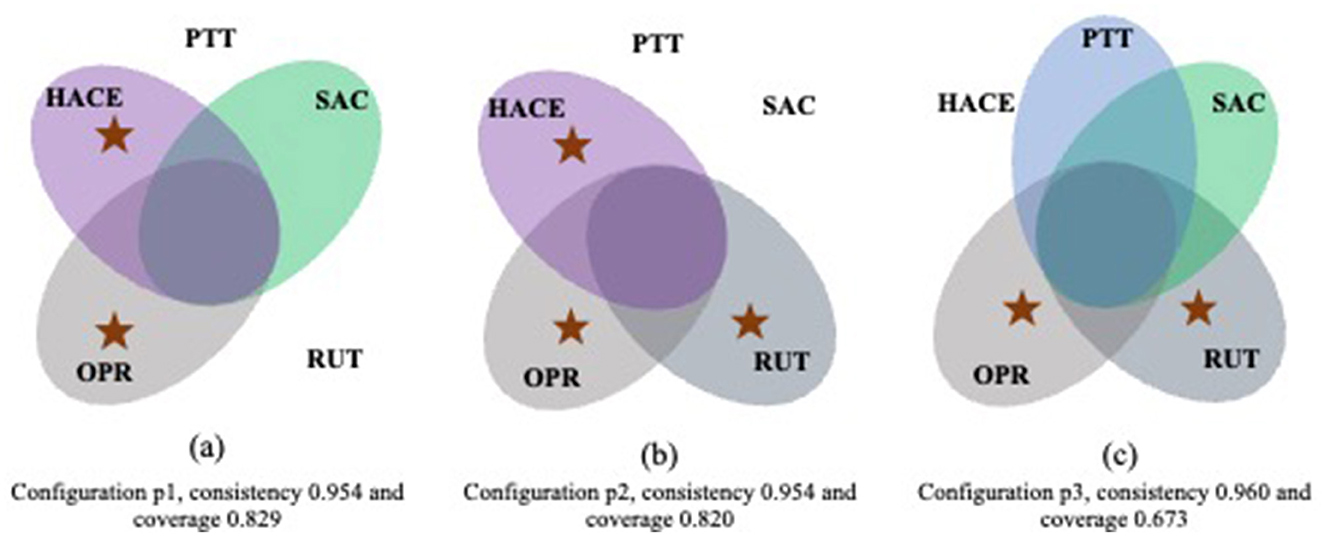
Figure 3. (a–c) Visualization of configuration p1, p2 and p3 for employee satisfaction. The ellipse, normal-presence of condition; no ellipse-absence of condition and ellipse with stars-necessary condition.
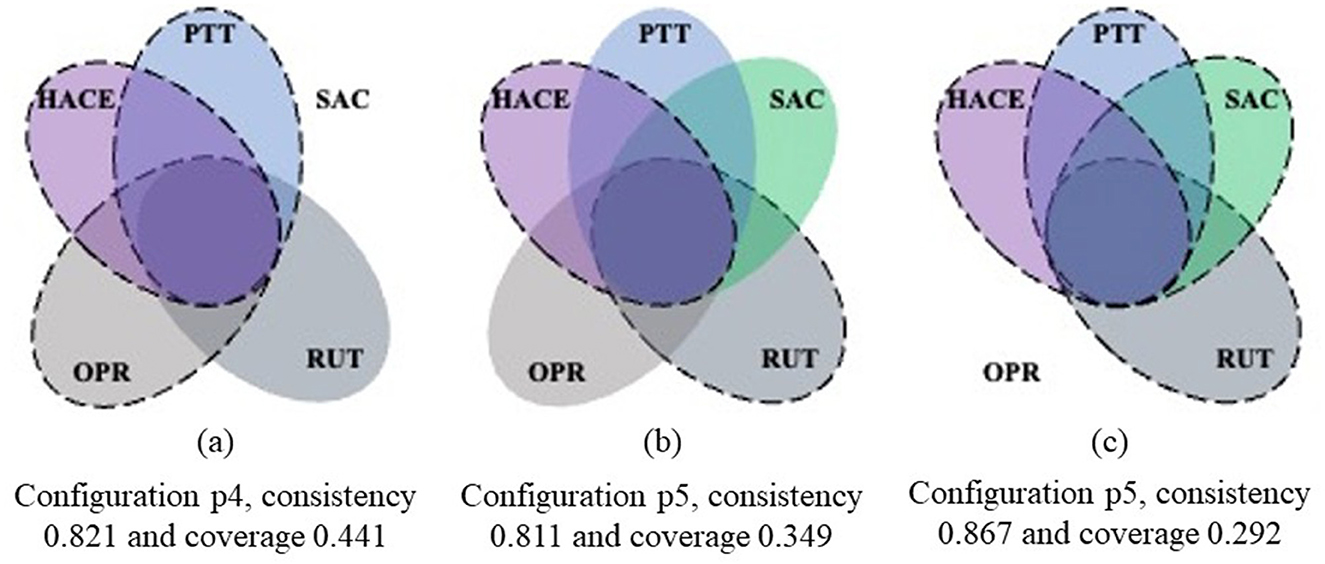
Figure 4. (a–c) Visualization of configuration p4, p5 and p6 for employee dissatisfaction. The ellipse, normal-presence of condition; no ellipse - absence of condition and dotted ellipse-absence of condition.
In contrast, configurations contributing to employee dissatisfaction (p4 to p6) reveal a fragmented alignment of conditions, resulting in an overall solution consistency of 0.760 and coverage of 0.518, supporting Proposition 2 (Pr.2). For instance, configuration p6 highlights the absence of operational effectiveness and resource utilization as key drivers of dissatisfaction, with a consistency of 0.867 and raw coverage of 0.292. This pathway demonstrates how the lack of efficient workflows and resource optimization creates significant barriers to satisfaction. Similarly, configuration p5 underscores the detrimental effects of missing service accessibility and processing time, highlighting the compounded impact of absent service-related constructs. These findings illustrate the multidimensional nature of dissatisfaction, where the misalignment or absence of critical drivers significantly undermines satisfaction levels.
To illustrate these employee-focused configurations, we identified two typical cases within our dataset: Case E1: (matching configuration p3, high satisfaction): a government employee reported that AI-based administrative tools significantly reduced waiting times for citizens, and the user interface was straightforward enough that staff could handle inquiries rapidly. This individual noted feeling “more motivated” due to being freed from repetitive tasks and appreciated how improved response speeds earned positive feedback from citizens. Case E2: (matching configuration p6, dissatisfaction): Another employee indicated that while AI tools were introduced, there was minimal training and no clear guidelines for allocating resources effectively. As a result, routine tasks piled up, and errors increased. This employee described feeling “overworked and undervalued,” attributing most problems to the AI system's incomplete integration into daily workflows. These example underscores how variations in service accessibility, processing time, and organizational readiness can shape employees' overall job satisfaction.
For citizen satisfaction as shown in Table 8, four configurations (p7 to p10) were identified, with high satisfaction pathways (p7 to p9) achieving an overall solution consistency of 0.987 and coverage of 0.960, confirming Proposition 1 (Pr.1). Configuration p7 emphasizes the critical role of service accuracy and transparency, achieving a consistency of 0.985 and raw coverage of 0.756. This pathway highlights the importance of trust-building constructs such as accurate and transparent service delivery in fostering citizen satisfaction. Configuration p8 integrates perceived service value and human-AI collaboration, achieving the highest consistency of 0.989 and a unique coverage of 0.882. These results showcase how the alignment of collaborative AI systems with perceived service value enhances citizen trust and satisfaction, demonstrating the complementary role of human-AI interaction in public service delivery. Conversely, the pathways leading to citizen dissatisfaction (p9 and p10) exhibit fragmented and misaligned conditions, resulting in an overall solution consistency of 0.884 and coverage of 0.642, confirming Proposition 2 (Pr.2). Configuration p9 reveals the absence of transparency and service accuracy as key contributors to dissatisfaction, achieving a consistency of 0.986 and raw coverage of 0.529. Configuration p10 highlights the cumulative impact of missing service accuracy, transparency, and human-AI collaboration, leading to a consistency of 0.853 and raw coverage of 0.476.
The configurational pathways for employee and citizen satisfaction reveal the intricate interplay of organizational and service-related constructs in AI-enabled public services. Employee satisfaction is driven by the alignment of operational effectiveness, resource utilization, and service accessibility, while citizen satisfaction is enabled by trust-enabling constructs such as service accuracy, transparency, and perceived service value. High satisfaction arises from cohesive and complementary conditions that align organizational goals with user needs, whereas dissatisfaction stems from fragmented and misaligned pathways where critical enablers are absent. These findings highlight the multidimensional nature of satisfaction outcomes and the critical role of integrating trust-building and service optimization mechanisms in public services. The visualized configurations (Figures 3–5) illustrate these pathways, offering insights into the specific combinations of factors that drive satisfaction or dissatisfaction, enabling organizations to refine their strategies for service delivery in AI-driven environments.
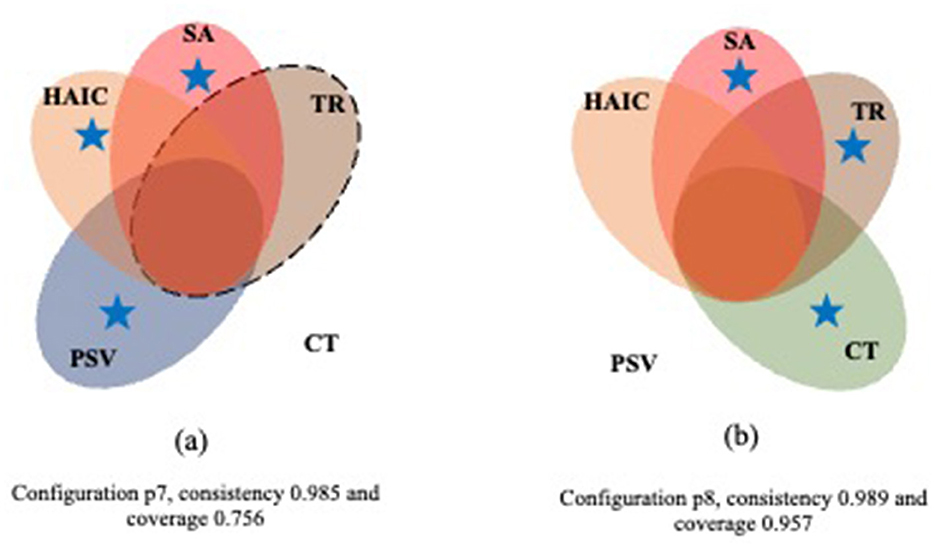
Figure 5. (a, b) Visualization of configuration p7 and p8 for citizens satisfaction. The ellipse, normal-presence of condition; no ellipse-absence of condition and dotted ellipse-absence of condition.
We also examined representative respondents who typify the citizen-focused configurations: case C1 (matching configuration p8, high satisfaction): One citizen praised the AI-driven service for accurately processing welfare applications and explaining eligibility criteria via a user-friendly chatbot. The individual mentioned a “strong sense of trust” in the system due to clear notifications about processing times and transparency around how decisions were made. Case C2 (matching configuration p9, dissatisfaction): another citizen expressed frustration over a lack of clarity about why their request was delayed. No updates were provided, and the system seemed prone to errors when entering personal details. They felt “ignored and mistrustful,” attributing dissatisfaction to poor service accuracy and minimal transparency. By highlighting these real-world examples, we show how satisfied and dissatisfied citizens experience AI-enabled services through distinct configurations of trust, service accuracy, transparency, and human-AI collaboration.
5.6 Model robustness testing
To validate the robustness of the fsQCA solution models for employee and citizen satisfaction, a predictive validity approach was implemented based on the guidelines of Pappas and Woodside (2021). The original sample was randomly divided into two groups: a subsample for initial analysis (N = 228 for employees, N = 214 for citizens) and a hold sample for robustness testing (N = 229 for employees, N = 215 for citizens). The subsample analysis began with truth table calibration and proceeded to the identification of sufficient configurations for each outcome. As shown in Table 9, two configurations (S1 and S2) were identified for employee satisfaction, with overall solution consistency and coverage values of 0.889 and 0.919, respectively. Configuration S1 highlights the importance of service accessibility, operational effectiveness, and human-AI collaboration, achieving a consistency of 0.914 and raw coverage of 0.761. Similarly, S2 integrates resource utilization with operational effectiveness and human-AI collaboration, achieving a consistency of 0.925 and raw coverage of 0.765.
For citizen satisfaction, one configuration (S3) was identified, demonstrating a robust alignment of service accuracy, transparency, citizen trust, perceived service value, and human-AI collaboration. This configuration achieved an exceptionally high consistency of 0.996 and raw coverage of 0.976, highlighting the indispensable role of trust and service-related constructs in fostering satisfaction. The overall solution coverage of 0.966 and consistency of 0.996 further validate the strength of the identified pathway. These results underscore the configurational complexity of satisfaction outcomes and highlight the alignment of multiple complementary antecedents as critical drivers for both employee and citizen satisfaction.
Next, the robustness of the identified solutions was tested using the hold sample (N=229 for employees, N = 215 for citizens) through the XY plot approach in fsQCA software. The predictive performance of the subsample solutions was evaluated against the hold sample, and the results are visualized in Figures 6a–c. For employee satisfaction, the consistency and coverage values for S1 and S2 remained high, with consistency values of 0.902 and 0.914, and coverage values of 0.735 and 0.759, respectively. Similarly, for citizen satisfaction, S3 maintained a consistency of 0.991 and coverage of 0.962, confirming the stability and predictive validity of the solution model. These values closely align with those obtained from the subsample, validating the generalizability of the configurations to an independent dataset.
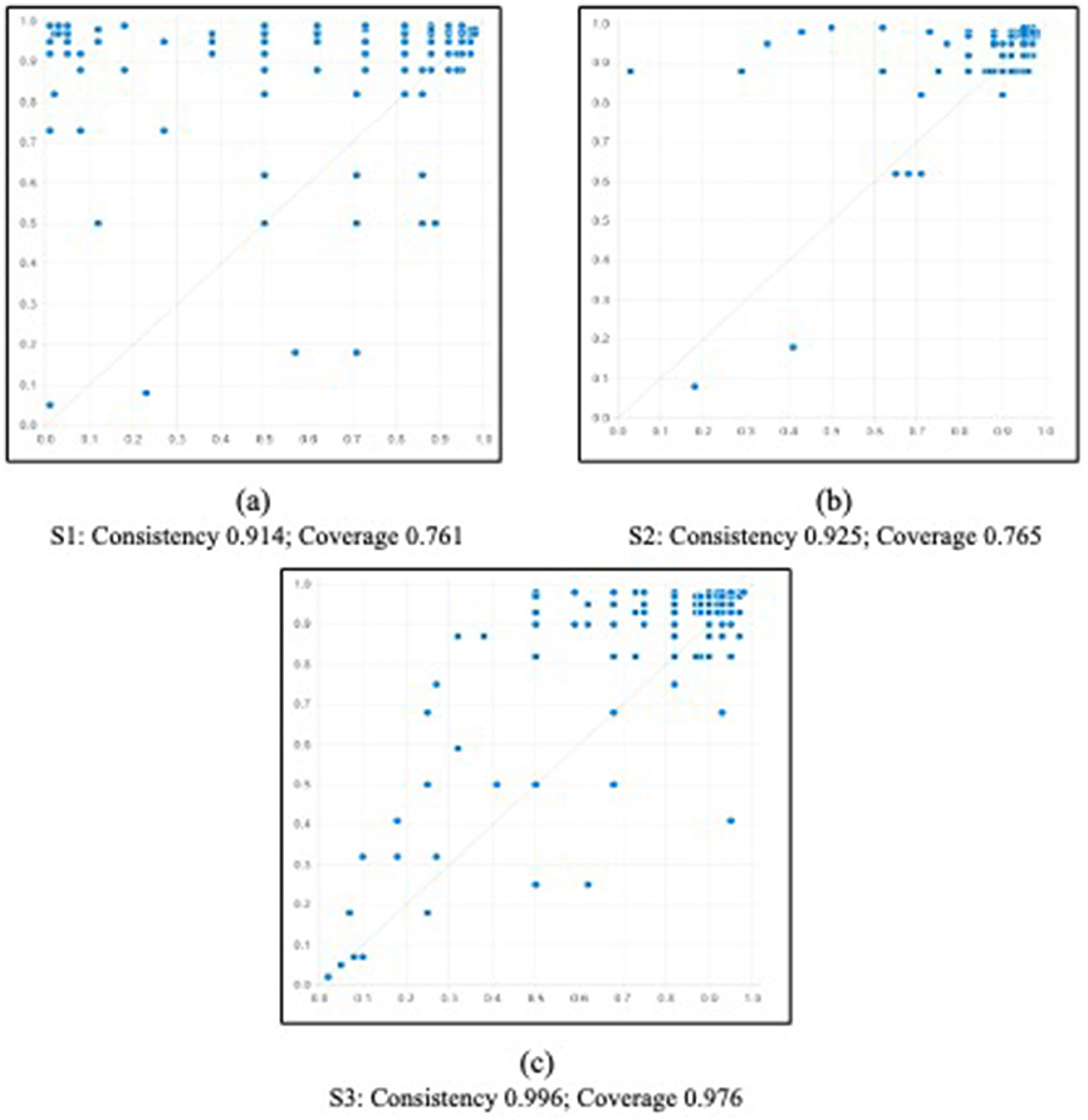
Figure 6. (a–c) The XY plot for sufficient configurations of s1 and s2 to predict employee satisfaction (N = 229) and $3 for citizens satisfaction (N = 215) based on hold samples.
The robustness testing highlights the stability of the solution models across different samples, ensuring that the configurations are not overfitted to the original subsample. For employees, service accessibility, operational effectiveness, and resource utilization emerge as pivotal constructs, while for citizens, trust-enabling constructs such as service accuracy, transparency, and perceived service value are key drivers. The predictive strength of these configurations illustrates their applicability in broader contexts of AI-enabled public services, ensuring reliable pathways for enhancing satisfaction outcomes. By demonstrating consistent results across both subsample and hold sample, the study establishes the robustness of its configurational approach to understanding satisfaction dynamics in AI-driven environments.
6 Discussion
Public Value Theory emphasizes trust, transparency, and equitable service delivery as central pillars of effective governance. Our results show that trust (e.g., perceived value and fairness) and transparency (e.g., clear process explanations, accountability mechanisms) are essential for high citizen satisfaction—particularly addressing RQ1, which explores how constructs like trust and perceived value influence citizen satisfaction in Indonesian AI-enabled public services. When AI systems provide accurate and transparent welfare benefits, they foster inclusivity and reliability, aligning with the PVT notion that public services should respond directly to citizen expectations (Criado and Gil-Garcia, 2019; Fatima et al., 2022). However, our analysis also reveals a tension between providing thorough explanations and avoiding information overload, highlighting that excessive detail can alienate citizens with limited digital literacy (Willems et al., 2022). In contexts like Indonesia (Koskimies and Kinder, 2024), where institutional trust may already be fragile, a carefully balanced approach to transparency is critical.
The findings further indicate that fragmented configurations—where trust-enabling factors are absent—lead to dissatisfaction, reinforcing PVT's stance that public value deteriorates if services appear opaque or biased. In short, PVT provides a lens through which AI deployments can be evaluated for inclusivity, equity, and fairness. The results confirm that merely implementing AI tools without addressing trust and transparency issues can undermine public confidence, thereby weakening the broader mission of public value creation.
While PVT addresses the “public-facing” side of AI-enabled services, the Resource-Based View underscores internal resource optimization to achieve operational efficiency and effectiveness. Our results highlight how constructs like operational effectiveness and resource utilization significantly influence employee satisfaction—directly aligning with RQ2, which focuses on organizational factors driving employee satisfaction in Indonesia's AI-driven context. Employees benefit when AI-driven automation eliminates repetitive tasks and enables them to focus on higher-value, strategic work (Chowdhury et al., 2022), increasing their engagement and sense of fulfillment. Conversely, poor integration or inadequate training can disrupt workflows, leading to dissatisfaction and resistance (He et al., 2023).
These observations resonate with RBV's emphasis on leveraging unique resources (in this case, AI capabilities and skilled human capital) to sustain competitive advantage. Effective AI deployments require thoughtful alignment between technology and internal processes. Our fsQCA findings reveal multiple equifinal pathways to high employee satisfaction, some of which prioritize resource utilization alongside service accessibility or processing time. This underscores that AI systems are not a one-size-fits-all solution; each agency or department may combine resources differently to achieve peak performance.
RQ3 examines how Human–AI collaboration mediates the balance between effectiveness and efficiency, directly bridging the citizen-centric concerns of PVT with the operational focus of RBV. Our analysis suggests that AI alone—even when highly efficient—cannot ensure ethical, inclusive service delivery without human oversight. This oversight provides ethical judgment and adaptability, addressing “black box” issues in AI-based decision-making. When integrated effectively, AI-driven systems can streamline day-to-day tasks, while humans uphold cultural sensitivity, equity, and trust-building measures. This synergy is especially critical in resource-constrained settings like Indonesia, where technological efficiency must coexist with diverse user needs.
RQ4, which explores which configurational pathways lead to satisfaction outcomes, is best illustrated through the lens of Human–AI collaboration: some pathways show that employees thrive when resource optimization and accessible AI systems are supported by human oversight. Similarly, citizens benefit from service accuracy, transparency, and trust-building measures guided by human involvement. In short, Human–AI collaboration unifies the outward-facing goals of public value and the inward-facing goals of resource optimization, providing a robust means to address the effectiveness–efficiency paradox in AI-enabled governance.
Concurrently, our findings demonstrate how PVT and RBV independently and collectively influence satisfaction outcomes in AI-enabled public services. PVT highlights the necessity of trust, transparency, and service accuracy to fulfill citizen expectations, while RBV emphasizes strategic deployment of organizational resources for operational effectiveness and employee engagement. Human–AI collaboration serves as the functional bridge between these perspectives, ensuring that AI-driven efficiency does not come at the expense of inclusive, accountable governance.
On a practical level, high citizen satisfaction hinges on careful attention to transparency and trust, while high employee satisfaction relies on optimized workflows and well-integrated AI support. Fragmented or absent constructs lead to dissatisfaction among both groups, highlighting the need for policymakers to harmonize these three dimensions rather than treat them in isolation. By fostering a culture of continual learning, robust ethical frameworks, and inclusive decision-making, public administrators can expand AI's transformative potential, ultimately guiding AI-driven public services toward greater responsiveness, fairness, and sustainability.
7 Implication
7.1 Implication for theory development
This study provides critical advancements in the theoretical understanding of AI-enabled public services by integrating PVT and the RBV within the context of Human-AI collaboration. While existing research has predominantly treated these frameworks independently, this study demonstrates their complementarity in addressing the effectiveness-efficiency paradox, offering a robust lens to decode dual satisfaction among citizens and employees. Specifically, the findings underscore that PVT emphasizes citizen-centric constructs like trust, transparency, and service accuracy, aligning with the societal expectations of fairness and inclusivity. Conversely, RBV contributes by optimizing resource utilization and operational effectiveness, revealing how these internal organizational factors enhance employee satisfaction. This theoretical integration enriches both frameworks, providing a holistic understanding of how technology can bridge the gap between citizen expectations and organizational objectives.
A key theoretical contribution lies in the study's configurational approach, which challenges traditional linear methodologies such as SEM. By employing fsQCA, the study captures the equifinal and asymmetrical nature of satisfaction outcomes. The findings reveal that satisfaction, whether among employees or citizens, emerges not from isolated constructs but through distinct pathways combining complementary conditions. For example, trust and transparency must align with service accuracy to foster high citizen satisfaction, while operational effectiveness and resource utilization must complement Human-AI collaboration to enhance employee satisfaction. This equifinality underscores the need to reconsider oversimplified linear models and adopt configurational methodologies to decode the complexity inherent in public service satisfaction. Consequently, the study not only advances methodological innovation but also provides a roadmap for future research to explore non-linear interactions in public administration contexts (Pappas and Woodside, 2021; Fiss, 2011).
This study also extends PVT by operationalizing trust and transparency in AI-enabled environments, addressing the evolving role of algorithmic decision-making in public administration. Prior research has established trust as foundational to public service delivery (Criado and Gil-Garcia, 2019; Willems et al., 2022), but the integration of AI introduces challenges such as algorithmic opacity and perceived risks of bias. This research enriches PVT by demonstrating that trust must be accompanied by operational mechanisms like service accuracy and ethical AI oversight to achieve citizen-centric outcomes. For instance, the study identifies transparency as a dual-edged construct: while it builds trust by clarifying decision-making processes, excessive or overly technical transparency risks alienating citizens with limited digital literacy. These insights advance the theoretical discourse on PVT, emphasizing the dynamic interplay between technology-driven transparency and societal trust. Additionally, the study addresses the gaps identified by Yap et al. (2021), who explored citizen satisfaction in Malaysia's e-government portals but overlooked broader organizational factors or trust-enabling constructs.
From the perspective of RBV, this study extends the framework by incorporating Human-AI collaboration as a critical resource for optimizing public service delivery. Traditional RBV literature focuses on tangible and intangible resources like infrastructure, knowledge, and human capital (Barney, 1991). However, the findings reveal that the synergy between human oversight and AI capabilities represents a new class of strategic resources in public administration. For example, AI systems enhance operational efficiency by automating repetitive tasks, while human judgment ensures adaptability, fairness, and ethical governance. This interplay addresses the limitations of RBV in technology-intensive environments, demonstrating how resource integration can overcome barriers to both employee and citizen satisfaction. By addressing the gaps identified by Alkhawaldah et al. (2024), who linked administrative empowerment to e-government adoption but did not explore the potential of Human-AI collaboration, this study provides a pathway to align AI-driven operational efficiency with the broader societal objectives of inclusivity and trust.
The study's emphasis on Human-AI collaboration introduces a novel dimension to both PVT and RBV, positioning it as a mediating mechanism that resolves the effectiveness-efficiency paradox. Previous studies, such as Lai et al. (2009) emphasized the role of trust-based institutions but failed to integrate operational resource optimization into their framework. By demonstrating that AI systems can enhance efficiency without compromising effectiveness when combined with human oversight, this research redefines the theoretical boundaries of PVT and RBV. For instance, the findings reveal that Human-AI collaboration fosters trust, transparency, and resource optimization simultaneously, ensuring that technological advancements support societal wellbeing rather than undermining it. This theoretical integration has significant implications for the broader discourse on digital transformation in public administration, providing actionable insights for achieving sustainable and equitable service delivery in diverse socio-cultural contexts.
Finally, the study advances the theoretical understanding of satisfaction as a multidimensional construct. By analyzing pathways to both high and low satisfaction, the research highlights the necessity of cohesive alignments among constructs. Fragmented configurations, such as the absence of transparency or operational effectiveness, contribute to dissatisfaction, reinforcing the importance of integrating complementary drivers in public service delivery. These findings not only extend existing theories but also pave the way for future studies to explore how emerging technologies like AI can redefine the parameters of satisfaction in public administration. By filling the gaps highlighted in Hasche et al. (2021), which focused narrowly on interpersonal trust without addressing external factors like technology integration, this study provides a more comprehensive framework for understanding the interplay of organizational, societal, and technological constructs in shaping satisfaction outcomes.
7.2 Implication for public administration practice
The study underscores the transformative potential of Human-AI collaboration in addressing the effectiveness-efficiency paradox in public services. AI systems can optimize routine operations such as permit processing and citizen inquiries, enabling employees to focus on strategic and complex tasks, thereby enhancing job satisfaction and service quality (Jiang et al., 2022; Chowdhury et al., 2022). For instance, municipalities leveraging AI to handle permit applications have reported reduced processing times and fewer administrative errors (Floridi, 2020). However, Human-AI collaboration is not without challenges. Resistance from employees, stemming from fears of redundancy or mistrust in AI's capabilities, can undermine adoption. To counter these barriers, public administrators must implement comprehensive training programs and foster participatory engagement during the design and implementation phases. By addressing these concerns, Human-AI collaboration can evolve into a strategic tool that enhances operational efficiency and employee satisfaction, aligning with broader institutional goals.
Transparency is pivotal in fostering citizen trust, as revealed by the study's findings. Transparent AI systems enhance accountability and reduce perceptions of bias, especially in services like welfare eligibility and tax assessments (Fatima et al., 2022; Wang et al., 2023). For example, AI tools used for social benefit distribution that explain eligibility criteria can mitigate distrust and improve citizen engagement (Koskimies and Kinder, 2024). However, transparency can also overwhelm citizens, particularly in regions with low digital literacy. Overly complex explanations of algorithmic decisions risk alienating users, leading to disengagement and reduced trust (Willems et al., 2022). Administrators must strike a balance by adopting user-centric approaches, such as simplified communication methods, multilingual support, and visual explanations. Furthermore, transparency must extend beyond communication to include robust ethical safeguards. Regular audits, compliance with international data protection standards, and the publication of algorithmic processes can reinforce public confidence in AI-enabled services.
Resource utilization is a key consideration for public administration, especially in resource-limited settings like Indonesia. AI technologies improve efficiency by reallocating resources to high-priority needs, optimizing workflows, and eliminating redundancies (Henkel et al., 2020; Wang and Zhao, 2024). For instance, predictive analytics can forecast citizen demand, enabling proactive resource allocation. However, this efficiency must be managed carefully. Poorly implemented AI systems may worsen inequities, such as favoring urban over rural areas in resource distribution. Policymakers should adopt governance frameworks that prioritize equitable access and involve diverse stakeholders to ensure balanced decision-making (Olan et al., 2022).
The study also emphasizes the importance of fostering citizen trust through service accuracy, perceived value, and ethical AI governance. Trust is fundamental to public service satisfaction and is built through reliable, transparent, and fair systems (Criado and Gil-Garcia, 2019; Robles and Mallinson, 2023). Personalized AI services, such as tailored healthcare or education recommendations, enhance perceived value and deepen trust (Koskimies and Kinder, 2024). However, these benefits come with risks. Overpersonalization may lead to ethical concerns, such as data privacy violations or discriminatory outcomes (Fatima et al., 2022). For instance, personalized welfare recommendations based on historical data may unintentionally perpetuate systemic biases. Policymakers must establish robust data governance policies, including privacy safeguards and algorithmic audits, to balance personalization with ethical integrity.
Collaborative governance is critical for aligning AI-enabled services with citizen and employee needs. The study highlights the benefits of involving diverse stakeholders in the co-design of public services, ensuring they are inclusive and effective (Koskimies and Kinder, 2024; Scutella et al., 2024). For example, pilot testing AI systems with citizen focus groups can identify usability issues and improve service delivery. Similarly, engaging employees in the design process can uncover operational bottlenecks and foster acceptance. However, collaboration requires substantial investment in time, resources, and capacity-building, which may strain already stretched public administration systems. Policymakers must weigh these costs against the long-term benefits of inclusive governance, including increased trust, satisfaction, and adaptability. Collaborative governance not only ensures that services reflect societal values but also enhances system resilience, enabling governments to navigate technological and social change effectively.
8 Conclusion, limitation, and future studies
This study provides significant insights into the dual challenges of effectiveness and efficiency in AI-enabled public services, focusing on achieving both citizen and employee satisfaction through the integration of PVT and the RBV. The findings reveal that trust, transparency, and service accuracy are pivotal to fostering citizen satisfaction, while resource utilization, operational effectiveness, and Human-AI collaboration are critical for employee satisfaction. By adopting a configurational approach using fsQCA, the research highlights multiple equifinal pathways to satisfaction, underscoring the multidimensional nature of public service optimization. This aligns with Criado and Gil-Garcia (2019) and Fatima et al. (2022), who emphasize the role of trust and transparency in public service delivery. The study advances theoretical understanding by demonstrating how PVT and RBV complement each other, providing a holistic framework to address the effectiveness-efficiency paradox. Practically, the findings offer actionable strategies for policymakers to design AI-driven public services that are inclusive, efficient, and citizen-centric, contributing to sustainable governance practices.
Despite its contributions, the study is not without limitations. First, the data collection was limited to public services in Indonesia, which may constrain the generalizability of the findings to other socio-cultural and institutional contexts. This is consistent with the challenges highlighted by Koskimies and Kinder (2024), who note that cultural diversity significantly influences public service outcomes. Future research could expand the geographical scope to include diverse regions, examining how cultural and policy differences influence satisfaction outcomes. Second, while this study employed fsQCA to identify complex pathways, it does not address longitudinal changes in satisfaction dynamics. Criado and Gil-Garcia (2019) also emphasize the importance of capturing evolving patterns in trust and satisfaction over time. Future studies could incorporate longitudinal designs to capture these dynamics. Additionally, the reliance on self-reported measures may introduce response biases, such as social desirability bias, potentially influencing the results. Employing mixed-method approaches, as recommended by Wang et al. (2023), could mitigate these biases by combining quantitative data with qualitative insights from in-depth interviews or case studies.
Building on these limitations, future studies should explore the broader implications of Human-AI collaboration in public services, particularly its ethical, social, and psychological dimensions. For instance, examining how AI integration influences employee wellbeing and job security across different organizational hierarchies could provide deeper insights into workforce adaptation, as suggested by Marikyan et al. (2022). Furthermore, future research should investigate the role of algorithmic fairness and inclusivity in fostering public trust, particularly in marginalized communities, as highlighted by Willems et al. (2022). Comparative studies across countries with varying levels of technological maturity could illuminate how AI adoption interacts with institutional readiness and citizen expectations (Koskimies and Kinder, 2024). By addressing these research gaps, future studies can enhance the theoretical and practical understanding of AI's transformative potential in public administration, contributing to more equitable and effective governance systems globally.
In addition, we propose the following future research questions to guide subsequent investigations:
1. How do different socio-cultural contexts mediate the impact of AI-based systems on citizen and employee satisfaction outcomes?
2. What strategies or governance models can best mitigate algorithmic biases, especially for underserved or marginalized populations?
3. How might longitudinal shifts in both citizen and employee perceptions alter the effectiveness of AI-enabled public services over time?
4. Which dimensions of Human-AI collaboration are most critical for sustaining employee wellbeing and organizational effectiveness in various public sector environments?**
By addressing these research gaps and questions, future studies can enhance the theoretical and practical understanding of AI's transformative potential in public administration, contributing to more equitable and effective governance systems globally.
Data availability statement
The original contributions presented in the study are included in the article/supplementary material, further inquiries can be directed to the corresponding authors.
Ethics statement
Ethical review and approval was not required for the study on human participants in accordance with the local legislation and institutional requirements. Written informed consent from the [patients/ participants OR patients/participants legal guardian/next of kin] was not required to participate in this study in accordance with the national legislation and the institutional requirements.
Author contributions
NR: Conceptualization, Investigation, Methodology, Resources, Validation, Writing – original draft, Writing – review & editing. AS: Conceptualization, Data curation, Formal analysis, Investigation, Methodology, Project administration, Resources, Supervision, Validation, Visualization, Writing – original draft, Writing – review & editing. DP: Data curation, Methodology, Resources, Validation, Visualization, Writing – original draft, Writing – review & editing. IE: Investigation, Methodology, Resources, Validation, Visualization, Writing – original draft, Writing – review & editing.
Funding
The author(s) declare that no financial support was received for the research and/or publication of this article.
Conflict of interest
The authors declare that the research was conducted in the absence of any commercial or financial relationships that could be construed as a potential conflict of interest.
Generative AI statement
The author(s) declare that no Gen AI was used in the creation of this manuscript.
Publisher's note
All claims expressed in this article are solely those of the authors and do not necessarily represent those of their affiliated organizations, or those of the publisher, the editors and the reviewers. Any product that may be evaluated in this article, or claim that may be made by its manufacturer, is not guaranteed or endorsed by the publisher.
References
Addis, S., Dvivedi, A., and Beshah, B. (2019). Quality management as a tool for job satisfaction improvement in low-level technology organizations: the case of Ethiopia. Prod. Plann. Control 30, 665–681. doi: 10.1080/09537287.2019.1574510
Alanezi, M. A., Mahmood, A. K., and Basri, S. (2012). E-government service quality: a qualitative evaluation in the case of Saudi Arabia. Electron. J. Inf. Syst. Dev. Countries 54, 1–20. doi: 10.1002/j.1681-4835.2012.tb00382.x
Alkhawaldah, R. A., Alshalabi, F. S., Alshawabkeh, Z. A. E., Almarshad, M. N., Al-Tahrawi, M. H., and Alshawabkeh, T. Z. A. (2024). The role of e-government in organizational effectiveness: the mediating role of administrative empowerment. Hum. Syst. Manage. 44, 432–447. doi: 10.1177/01672533241295510
Alon-Barkat, S., and Busuioc, M. (2023). Human-AI interactions in public sector decision making: ‘automation bias' and ‘selective adherence' to algorithmic advice. J. Pub. Adm. Res. Theory 33, 153–169. doi: 10.1093/jopart/muac007
Ashok, M., Madan, R., Joha, A., and Sivarajah, U. (2022). Ethical framework for artificial intelligence and digital technologies. Int. J. Inf. Manage. 62:102433. doi: 10.1016/j.ijinfomgt.2021.102433
Barney, J. (1991). Firm resources and sustained competitive advantage. J. Manage. 17, 99–120. doi: 10.1177/014920639101700108
Baumgartner, H., Weijters, B., and Pieters, R. (2021). The biasing effect of common method variance: some clarifications. J. Acad. Mark. Sci. 49, 221–235. doi: 10.1007/s11747-020-00766-8
Benington, J., and Moore, M. (2010). Public Value: Theory and Practice. London: Bloomsbury Publishing. doi: 10.1007/978-0-230-36431-8
Bouckaert, G., and Van de Walle, S. (2003). Comparing measures of citizen trust and user satisfaction as indicators of ‘good governance': difficulties in linking trust and satisfaction indicators. Int. Rev. Adm. Sci. 69, 329–343. doi: 10.1177/00208523030693003
Caldwell, C., and Hayes, L.A. (2007). Leadership, trustworthiness, and the mediating lens. J. Manage. Dev. 26, 261–281. doi: 10.1108/02621710710732155
Chan, F. K., Thong, J. Y., Brown, S. A., and Venkatesh, V. (2021). Service design and citizen satisfaction with e-government services: a multidimensional perspective. Public Adm. Rev. 81, 874–894. doi: 10.1111/puar.13308
Chatterjee, S., Khorana, S., and Kizgin, H. (2022). Harnessing the potential of artificial intelligence to foster citizens' satisfaction: an empirical study on India. Gov. Inf. Q. 39:101621. doi: 10.1016/j.giq.2021.101621
Chen, T., Guo, W., Gao, X., and Liang, Z. (2021). AI-based self-service technology in public service delivery: user experience and influencing factors. Gov. Inf. Q. 38:101520. doi: 10.1016/j.giq.2020.101520
Chowdhury, S., Budhwar, P., Dey, P. K., Joel-Edgar, S., and Abadie, A. (2022). AI-employee collaboration and business performance: integrating knowledge-based view, socio-technical systems, and organisational socialisation framework. J. Bus. Res. 144, 31–49. doi: 10.1016/j.jbusres.2022.01.069
Cranefield, J., Winikoff, M., Chiu, Y. T., Li, Y., Doyle, C., and Richter, A. (2023). Partnering with AI: the case of digital productivity assistants. J. R. Soc. New Zealand 53, 95–118. doi: 10.1080/03036758.2022.2114507
Criado, J. I., and Gil-Garcia, J. R. (2019). Creating public value through smart technologies and strategies: from digital services to artificial intelligence and beyond. Int. J. Public Sector Manage. 32, 438–450. doi: 10.1108/IJPSM-07-2019-0178
De Fine Licht, K., and de Fine Licht, J. (2020). Artificial intelligence, transparency, and public decision-making: why explanations are key when trying to produce perceived legitimacy. AI Soc. 35, 917–926. doi: 10.1007/s00146-020-00960-w
Desiere, S., and Struyven, L. (2021). Using artificial intelligence to classify jobseekers: the accuracy-equity trade-off. J. Soc. Policy 50, 367–385. doi: 10.1017/S0047279420000203
Evans, J. R., and Lindsay, W. M. (2011). The Management and Control of Quality. Mason, OH: South-Western Cengage Learning.
Fatima, S., Desouza, K. C., Buck, C., and Fielt, E. (2022). Public AI canvas for AI-enabled public value: a design science approach. Gov. Inf. Q. 39:101722. doi: 10.1016/j.giq.2022.101722
Fiss, P. C. (2011). Building better causal theories: a fuzzy set approach to typologies in organization research. Acad. Manage. J. 54, 393–420. doi: 10.5465/amj.2011.60263120
Flathmann, C., Schelble, B. G., Rosopa, P. J., McNeese, N. J., Mallick, R., and Madathil, K. C. (2023). Examining the impact of varying levels of AI teammate influence on human-AI teams. Int. J. Hum. Comp. Stud. 177:103061. doi: 10.1016/j.ijhcs.2023.103061
Fleischer, J., and Wanckel, C. (2024). Job satisfaction and the digital transformation of the public sector: the mediating role of job autonomy. Rev. Public Pers. Adm. 44, 431–452. doi: 10.1177/0734371X221148403
Floridi, L. (2020). Artificial intelligence as a public service: learning from Amsterdam and Helsinki. Philos. Technol. 33, 541–546. doi: 10.1007/s13347-020-00434-3
Florini, A. (2007). The Right to Know: Transparency for an Open World. New York: Columbia University Press. doi: 10.7312/flor14158
Fukumoto, E., and Bozeman, B. (2019). Public values theory: what is missing? Am. Rev. Public Adm. 49, 635–648. doi: 10.1177/0275074018814244
Grimmelikhuijsen, S. (2012). Linking transparency, knowledge, and citizen trust in government: an experiment. Int. Rev. Adm. Sci. 78, 50–73. doi: 10.1177/0020852311429667
Hair, J., Hollingsworth, C. L., Randolph, A. B., and Chong, A. Y. L. (2017). An updated and expanded assessment of PLS-SEM in information systems research. Indust. Manage. Data Syst. 117, 442–458. doi: 10.1108/IMDS-04-2016-0130
Harter, J. K., Schmidt, F. L., and Hayes, T.L. (2002). Business-unit-level relationship between employee satisfaction, employee engagement, and business outcomes: a meta-analysis. J. Appl. Psychol. 87:268. doi: 10.1037/0021-9010.87.2.268
Hasche, N., Höglund, L., and Mårtensson, M. (2021). Intra-organizational trust in public organizations: the study of interpersonal trust in both vertical and horizontal relationships from a bidirectional perspective. Public Manage. Rev. 23, 1768–1788. doi: 10.1080/14719037.2020.1764081
He, C., Teng, R., and Song, J. (2023). Linking employees' challenge-hindrance appraisals toward AI to service performance: the influences of job crafting, job insecurity, and AI knowledge. Int. J. Contemp. Hosp. Manage. 36, 975–994. doi: 10.1108/IJCHM-07-2022-0848
Heald, D. (2006). “Varieties of transparency,” in Transparency: The Key to Better Governance?, eds, C. Hood and D. Heald (Oxford: Oxford University Press for The British Academy), 25–43. doi: 10.5871/bacad/9780197263839.003.0002
Henkel, A. P., Bromuri, S., Iren, D., and Urovi, V. (2020). Half human, half machine: augmenting service employees with AI for interpersonal emotion regulation. J. Serv. Manage. 31, 247–265. doi: 10.1108/JOSM-05-2019-0160
Hong, S. G., and Lee, D. (2023). Development of a citizen participation public service innovation model based on smart governance. Serv. Bus. 17, 669–694. doi: 10.1007/s11628-023-00536-w
Hou, K., Hou, T., and Cai, L. (2023). Exploring trust in human-AI collaboration in the context of multiplayer online games. Systems 11:217. doi: 10.3390/systems11050217
Javed, M. U., Javaid, N., Aldegheishem, A., Alrajeh, N., Tahir, M., and Ramzan, M. (2020). Scheduling charging of electric vehicles in a secured manner by emphasizing cost minimization using blockchain technology and IPFS. Sustainability 12:5151. doi: 10.3390/su12125151
Jiang, J., Kahai, S., and Yang, M. (2022). Who needs explanation and when? Juggling explainable AI and user epistemic uncertainty. Int. J. Hum. Comp. Stud. 165:102839. doi: 10.1016/j.ijhcs.2022.102839
Kalambokidis, L. (2014). Creating public value with tax and spending policies: the view from public economics. Public Adm. Rev. 74, 519–526. doi: 10.1111/puar.12162
Kim, Y., Myeong, S., and Ahn, M. J. (2023). Living labs for AI-enabled public services: functional determinants, user satisfaction, and continued use. Sustainability 15:8672. doi: 10.3390/su15118672
Kleizen, B., Van Dooren, W., Verhoest, K., and Tan, E. (2023). Do citizens trust trustworthy artificial intelligence? Experimental evidence on the limits of ethical AI measures in government. Gov. Inf. Q. 40:101834. doi: 10.1016/j.giq.2023.101834
Koskimies, E., and Kinder, T. (2024). Mutuality in AI-enabled new public service solutions. Public Manage. Rev. 26, 219–244. doi: 10.1080/14719037.2022.2078501
Koskimies, E., Stenvall, J., Kinder, T., Leikas, J., and Nieminen, M. (2022). “Artificial intelligence and public innovations,” in Public Innovation and Digital Transformation (London: Routledge), 68. doi: 10.4324/9781003230854-5
Kulal, A., Rahiman, H. U., Suvarna, H., Abhishek, N., and Dinesh, S. (2024). Enhancing public service delivery efficiency: exploring the impact of AI. J. Open Innovation Technol. Mark. Complex. 10:100329. doi: 10.1016/j.joitmc.2024.100329
Kumar, R., Kumar, R., Sachan, A., and Gupta, P. (2021). An examination of the e-government service value chain. Inf. Technol. People 34, 889–911. doi: 10.1108/ITP-09-2018-0438
Lai, K. K., Liu, T. H., and Kao, F. C. (2009). Why is quality improving continuously? An integrated perspective of institution theory and the resource-based view of the firm. Total Qual. Manage. 20, 1111–1122. doi: 10.1080/14783360903247098
Le, K. B. Q., Sajtos, L., and Fernandez, K. V. (2023). Employee-(Ro)Bot collaboration in service: an interdependence perspective. J. Serv. Manage. 34, 176–207. doi: 10.1108/JOSM-06-2021-0232
Li, Y., Fan, Y., and Nie, L. (2023). Making governance agile: exploring the role of artificial intelligence in China's local governance. Public Policy Adm. 40, 1–24. doi: 10.1177/09520767231188229
Li, Y., and Shang, H. (2020). Service quality, perceived value, and citizens' continuous-use intention regarding e-government: empirical evidence from China. Inf. Manage. 57:103197. doi: 10.1016/j.im.2019.103197
Liu, B., Chen, T., Jia, P., and Wang, L. (2020). Effective public service delivery supported by time-decayed Bayesian personalized ranking. Know. Based Syst. 206:106376. doi: 10.1016/j.knosys.2020.106376
Mansoor, M. (2021). Citizens' trust in government as a function of good governance and government agency's provision of quality information on social media during COVID-19. Gov. Inf. Q. 38:101597. doi: 10.1016/j.giq.2021.101597
Marikyan, D., Papagiannidis, S., Rana, O. F., Ranjan, R., and Morgan, G. (2022). “Alexa, let's talk about my productivity”: the impact of digital assistants on work productivity. J. Bus. Res. 142, 572–584. doi: 10.1016/j.jbusres.2022.01.015
Mikhaylov, S. J., Esteve, M., and Campion, A. (2018). Artificial intelligence for the public sector: opportunities and challenges of cross-sector collaboration. Philos. Trans. R. Soc. A. Math. Phys. Eng. Sci. 376:20170357. doi: 10.1098/rsta.2017.0357
Mishra, L., and Varma, S. (2020). Performance evaluation of real-time stream processing systems for Internet of Things applications. Future Gen. Comp. Syst. 113, 207–217. doi: 10.1016/j.future.2020.07.012
Moore, M. H. (1997). Creating Public Value: Strategic Management in Government. Cambridge, MA: Harvard University Press.
Mukherjee, P. K. (2022). “Artificial intelligence-based smart government enterprise architecture (AI-SGEA) framework,” in International Symposium on Artificial Intelligence (Cham: Springer Nature Switzerland), 325–333. doi: 10.1007/978-3-031-22485-0_30
Noor, N., Rao Hill, S., and Troshani, I. (2022). Recasting service quality for AI-based service. Aust. Mark. J. 30, 297–312. doi: 10.1177/18393349211005056
Olan, F., Arakpogun, E. O., Suklan, J., Nakpodia, F., Damij, N., and Jayawickrama, U. (2022). Artificial intelligence and knowledge sharing: contributing factors to organizational performance. J. Bus. Res. 145, 605–615. doi: 10.1016/j.jbusres.2022.03.008
Osei-Kojo, A. (2017). E-government and public service quality in Ghana. J. Public Aff. 17:e1620. doi: 10.1002/pa.1620
Pandey, J. K. (2024). Evaluating public service value within collaborative e-governance: a study in the Indian context. Digit. Trans. Soc. 3, 197–213. doi: 10.1108/DTS-08-2023-0065
Pappas, I. O., and Woodside, A. G. (2021). Fuzzy-set qualitative comparative analysis (fsQCA): guidelines for research practice in Information Systems and marketing. Int. J. Inf. Manage. 58:102310. doi: 10.1016/j.ijinfomgt.2021.102310
Prebble, M. (2018). Is ‘we' singular? The nature of public value. Am. Rev. Public Adm. 48, 103–118. doi: 10.1177/0275074016671427
Prokop, C., and Tepe, M. (2022). Talk or type? The effect of digital interfaces on citizens' satisfaction with standardized public services. Public Adm. 100, 427–443. doi: 10.1111/padm.12739
Prysmakova, P. (2021). Contact with citizens and job satisfaction: expanding person-environment models of public service motivation. Public Manage. Rev. 23, 1339–1358. doi: 10.1080/14719037.2020.1751252
Ragin, C. C. (2023). Analytic Induction for Social Research. Oakland: University of California Press, 142. doi: 10.1525/luminos.159
Robles, P., and Mallinson, D. J. (2023). Artificial intelligence technology, public trust, and effective governance. Rev. Policy Res. Early View 42, 1–18. doi: 10.1111/ropr.12555
Santa, R., MacDonald, J. B., and Ferrer, M. (2019). The role of trust in e-government effectiveness, operational effectiveness, and user satisfaction: lessons from Saudi Arabia in e-G2B. Gov. Inf. Q. 36, 39–50. doi: 10.1016/j.giq.2018.10.007
Scutella, M., Plewa, C., and Reaiche, C. (2024). Virtual agents in the public service: examining citizens' value-in-use. Public Manage. Rev. 26, 73–88. doi: 10.1080/14719037.2022.2044504
Tan, S. C., Chen, W., and Chua, B. L. (2023). Leveraging generative artificial intelligence based on large language models for collaborative learning. Learn. Res. Pract. 9, 125–134. doi: 10.1080/23735082.2023.2258895
Vassilakopoulou, P., Haug, A., Salvesen, L. M., and Pappas, I. O. (2023). Developing human/AI interactions for chat-based customer services: lessons learned from the Norwegian government. Eur. J. Inf. Syst. 32, 10–22. doi: 10.1080/0960085X.2022.2096490
Véronneau, S., and Cimon, Y. (2007). Maintaining robust decision capabilities: an integrative human-systems approach. Decis. Support Syst. 43, 127–140. doi: 10.1016/j.dss.2006.08.003
Vigoda, E. (2000). Are you being served? The responsiveness of public administration to citizens' demands: an empirical examination in Israel. Public Adm. 78, 165–191. doi: 10.1111/1467-9299.00198
Wagenheim, G. D., and Reurink, J.H. (1991). Customer service in public administration. Public Adm. Rev. 51, 263–270. doi: 10.2307/976950
Wan, X., Jha, A. K., Kazantsev, N., and Boh, W. F. (2023). Online-to-offline platforms: examining the effects of demand-side usage on supply-side decisions. Inf. Manage. 60:103757. doi: 10.1016/j.im.2023.103757
Wang, C., Teo, T. S., and Janssen, M. (2021). Public and private value creation using artificial intelligence: an empirical study of AI voice robot users in the Chinese public sector. Int. J. Inf. Manage. 61:102401. doi: 10.1016/j.ijinfomgt.2021.102401
Wang, D., and Zhao, X. (2024). Effect of resource integration on organizational resilience of megaprojects: role of dynamic capability and resource availability. J. Asian Archit. Build. Eng. Early View, 24, 1–16. doi: 10.1080/13467581.2024.2329357
Wang, Y-. F., Chen, Y-. C., and Chien, S.-Y. (2023). Citizens' intention to follow recommendations from a government-supported AI-enabled system. Public Policy Adm. 40, 1–23. doi: 10.1177/09520767231176126
Wernerfelt, B. (1984). A resource-based view of the firm. Strategic Manage. J. 5, 171–180. doi: 10.1002/smj.4250050207
Willems, J., Schmid, M. J., Vanderelst, D., Vogel, D., and Ebinger, F. (2023). AI-driven public services and the privacy paradox: do citizens really care about their privacy? Public Manage. Rev. 25, 2116–2134. doi: 10.1080/14719037.2022.2063934
Willems, J., Schmidthuber, L., Vogel, D., Ebinger, F., and Vanderelst, D. (2022). Ethics of robotized public services: the role of robot design and its actions. Gov. Inf. Q. 39:101683. doi: 10.1016/j.giq.2022.101683
Williams, I., and Shearer, H. (2011). Appraising public value: past, present, and futures. Public Adm. 89, 1367–1384. doi: 10.1111/j.1467-9299.2011.01942.x
Wixom, B. H., and Todd, P. A. (2005). A theoretical integration of user satisfaction and technology acceptance. Inf. Syst. Res. 16, 85–102. doi: 10.1287/isre.1050.0042
Yap, C. S., Ahmad, R., Newaz, F. T., and Mason, C. (2021). Continuous use and extended use of e-government portals in Malaysia. Int. J. Public Adm. 44, 1329–1340. doi: 10.1080/01900692.2020.1759626
Yigitcanlar, T., Li, R. Y. M., Beeramoole, P. B., and Paz, A. (2023). Artificial intelligence in local government services: public perceptions from Australia and Hong Kong. Gov. Inf. Q. 40:101833. doi: 10.1016/j.giq.2023.101833
Yin, Y., Di, Q., Wan, J., and Liang, T. (2023). Time-aware smart city services based on QoS prediction: a contrastive learning approach. IEEE Internet Things J. 10, 18745–18753. doi: 10.1109/JIOT.2023.3281869
Young, M. M., Bullock, J. B., and Lecy, J. D. (2019). Artificial discretion as a tool of governance: a framework for understanding the impact of artificial intelligence on public administration. Perspect. Public Manage. Gov. 2, 301–313. doi: 10.1093/ppmgov/gvz014
Yue, B., and Li, H. (2023). The impact of human-AI collaboration types on consumer evaluation and usage intention: a perspective of responsibility attribution. Front. Psychol. 14:1277861. doi: 10.3389/fpsyg.2023.1277861
Keywords: AI in public services, efficiency vs. effectiveness paradox, service quality, citizen satisfaction, employee satisfaction, configurational pathways
Citation: Rulandari N, Silalahi ADK, Phuong DTT and Eunike IJ (2025) Decoding effectiveness and efficiency in AI-enabled public services: a configurational pathway to citizen and employee satisfaction. Front. Polit. Sci. 7:1560180. doi: 10.3389/fpos.2025.1560180
Received: 14 January 2025; Accepted: 20 June 2025;
Published: 29 July 2025.
Edited by:
Priyabala Singh, University of Delhi, IndiaReviewed by:
Mona Ashok, University of Reading, United KingdomZitao Chen, Shanghai Jiao Tong University, China
Copyright © 2025 Rulandari, Silalahi, Phuong and Eunike. This is an open-access article distributed under the terms of the Creative Commons Attribution License (CC BY). The use, distribution or reproduction in other forums is permitted, provided the original author(s) and the copyright owner(s) are credited and that the original publication in this journal is cited, in accordance with accepted academic practice. No use, distribution or reproduction is permitted which does not comply with these terms.
*Correspondence: Andri Dayarana K. Silalahi, YW5kcmlka3NpbGFsYWhpQGdtYWlsLmNvbQ==; Ixora Javanisa Eunike, aXhvcmFqYXZhbmlzYWV1bmlrZUBnbWFpbC5jb20=
 Novianita Rulandari1
Novianita Rulandari1 Andri Dayarana K. Silalahi
Andri Dayarana K. Silalahi Ixora Javanisa Eunike
Ixora Javanisa Eunike